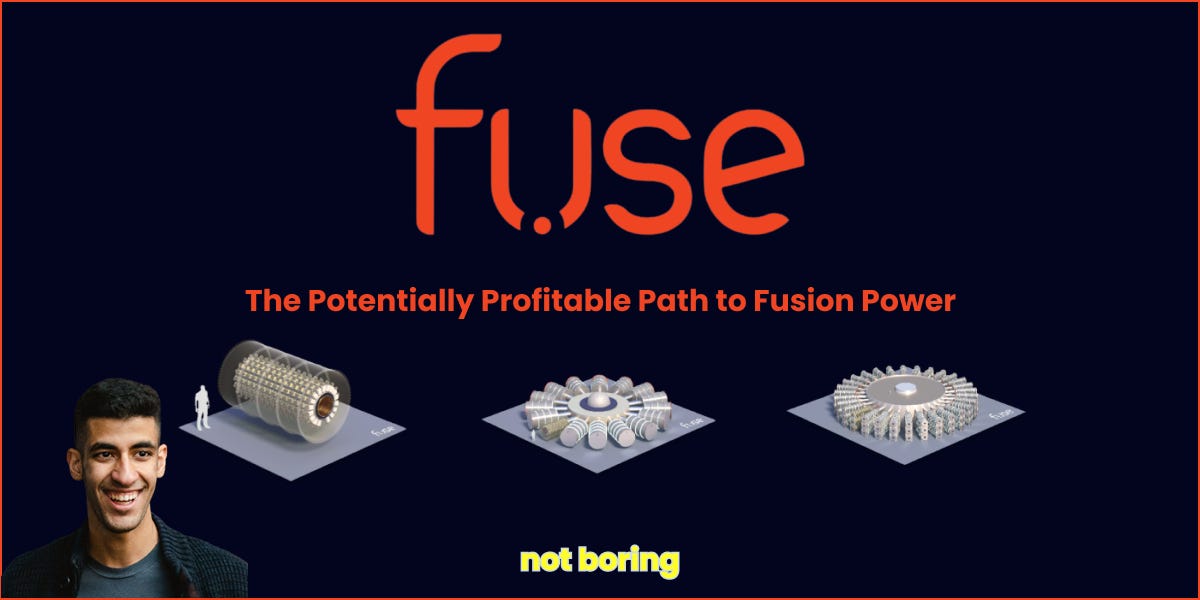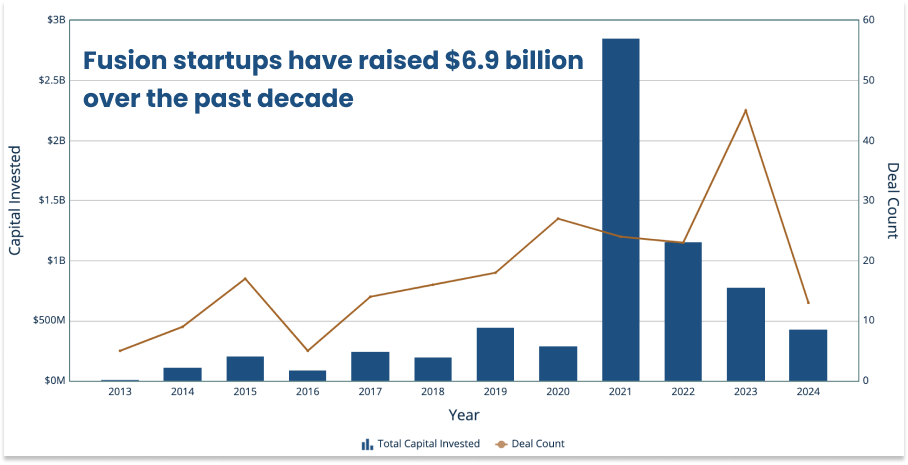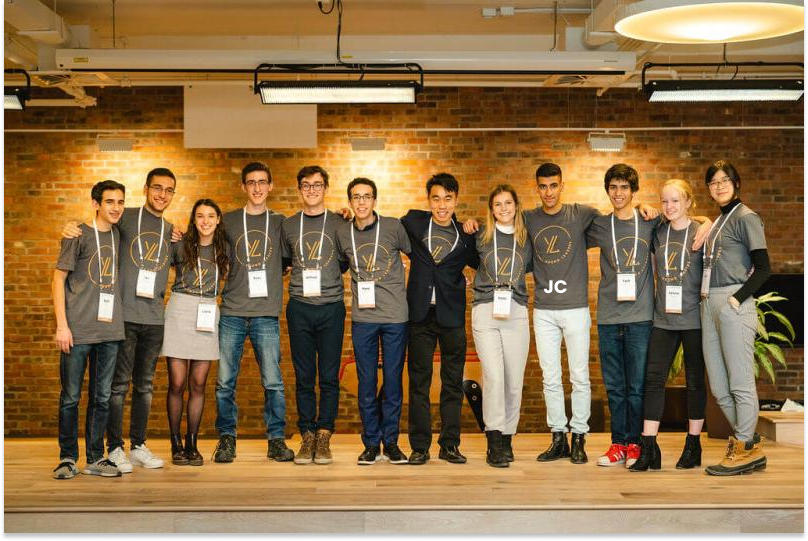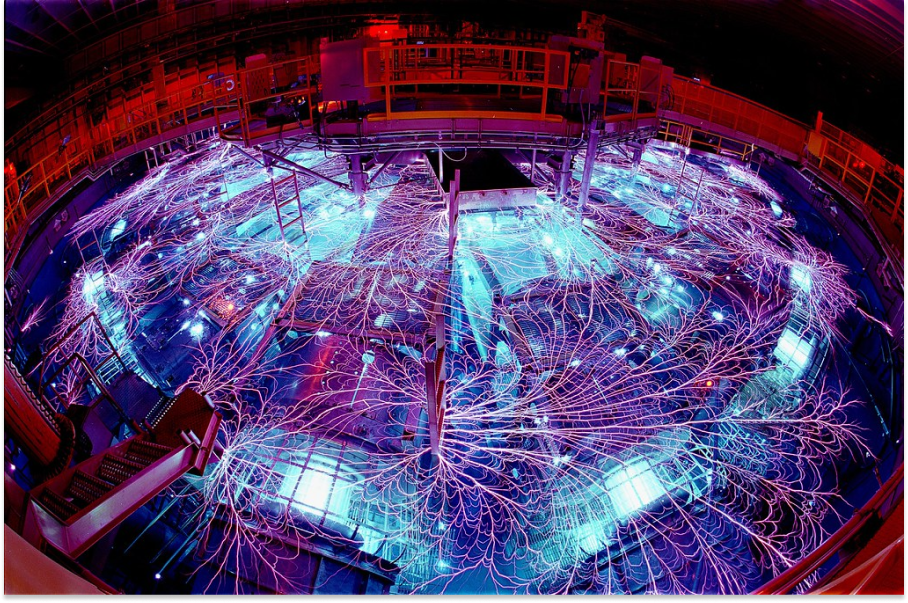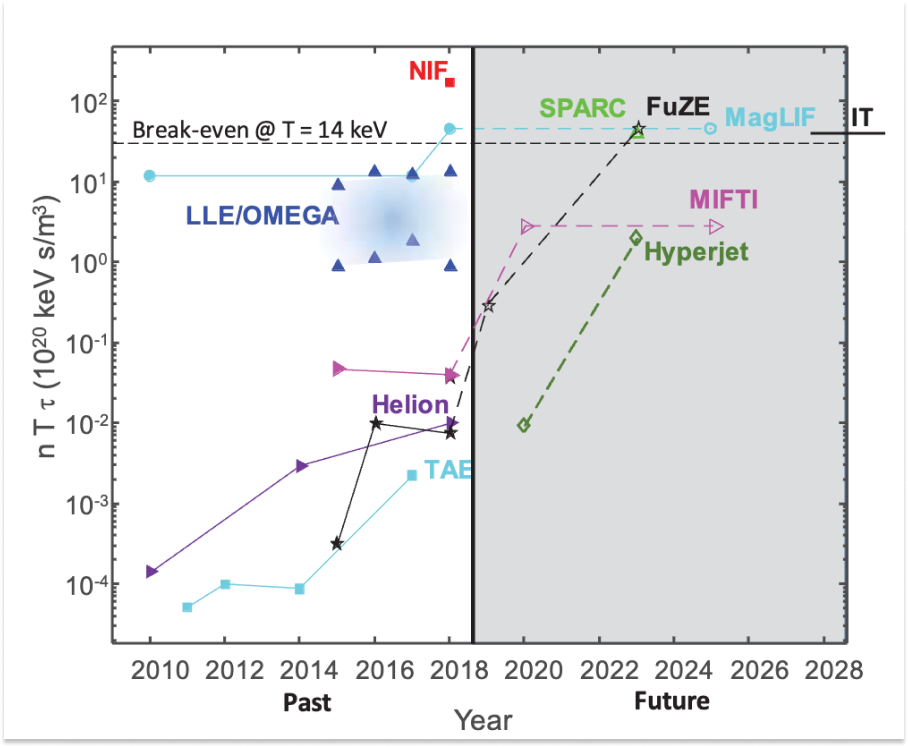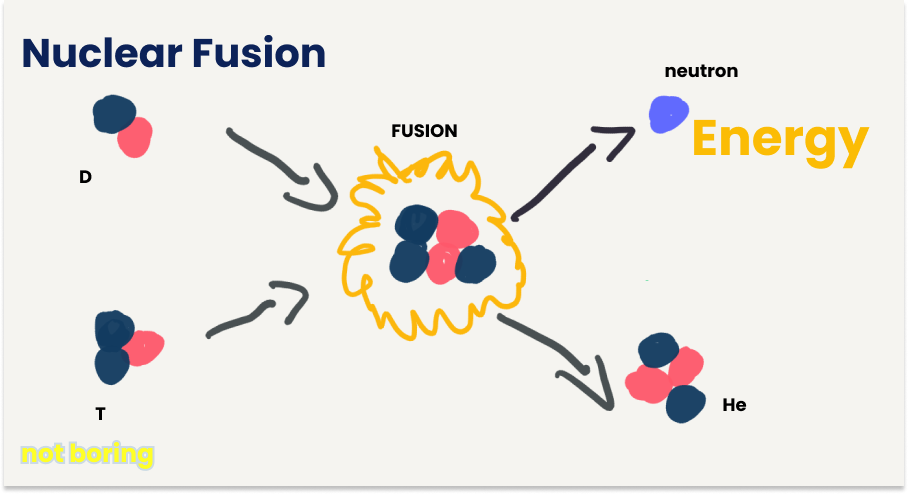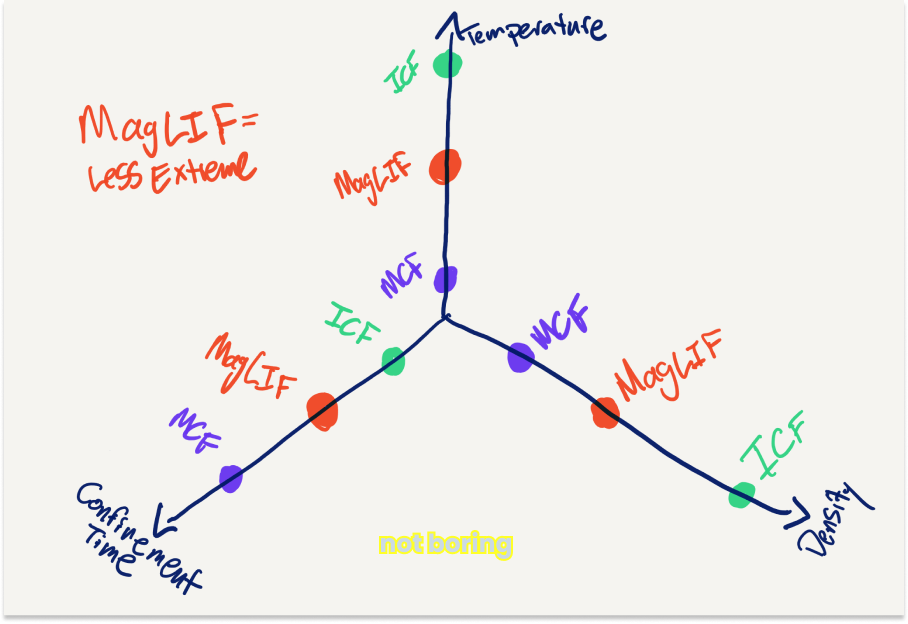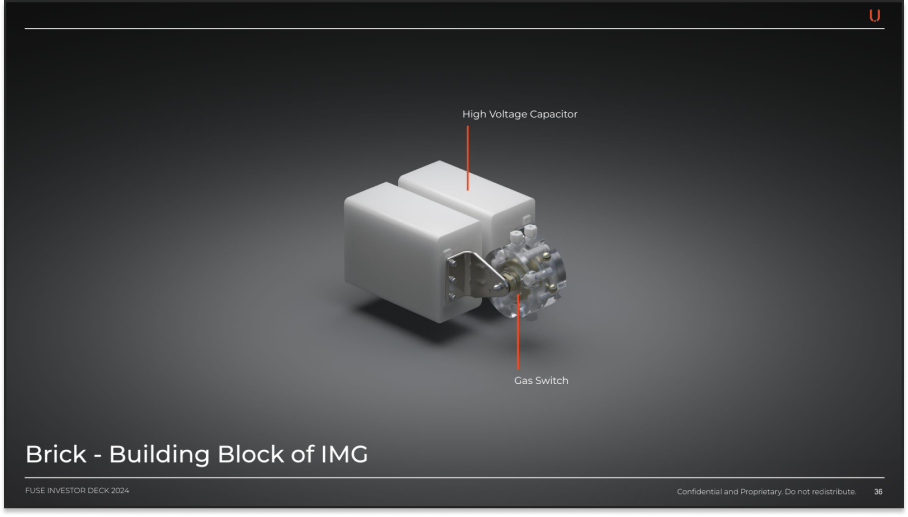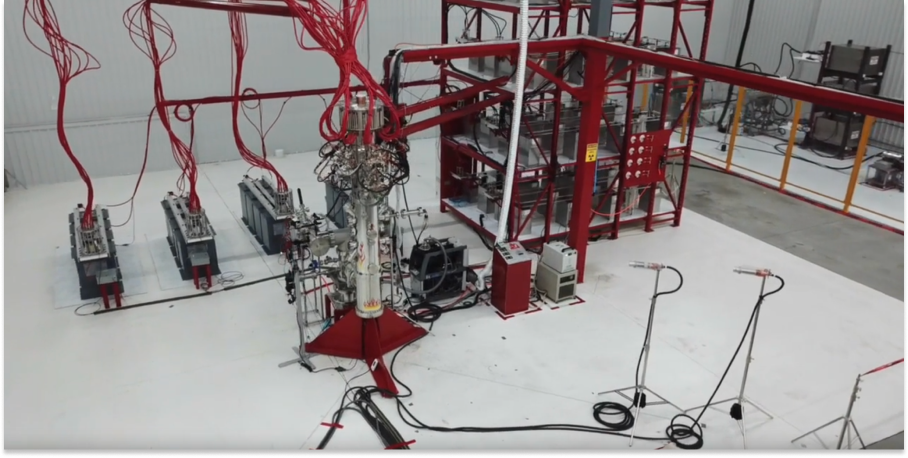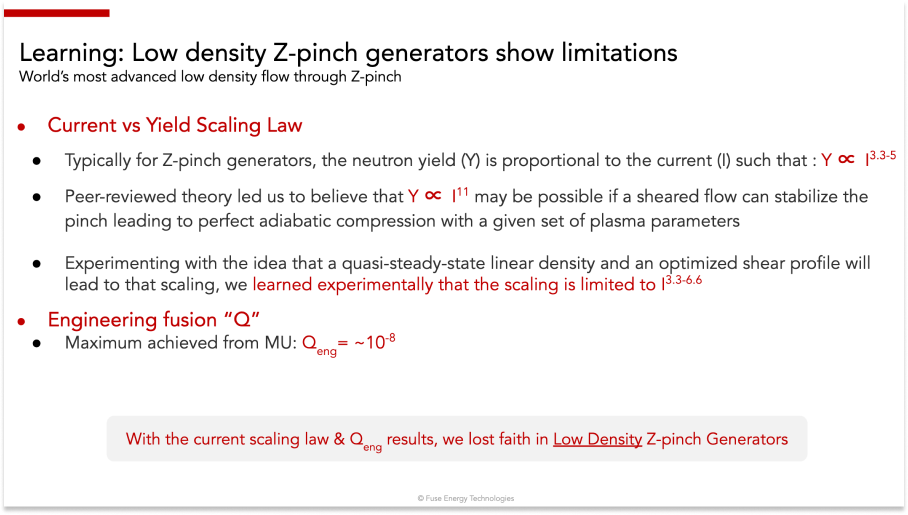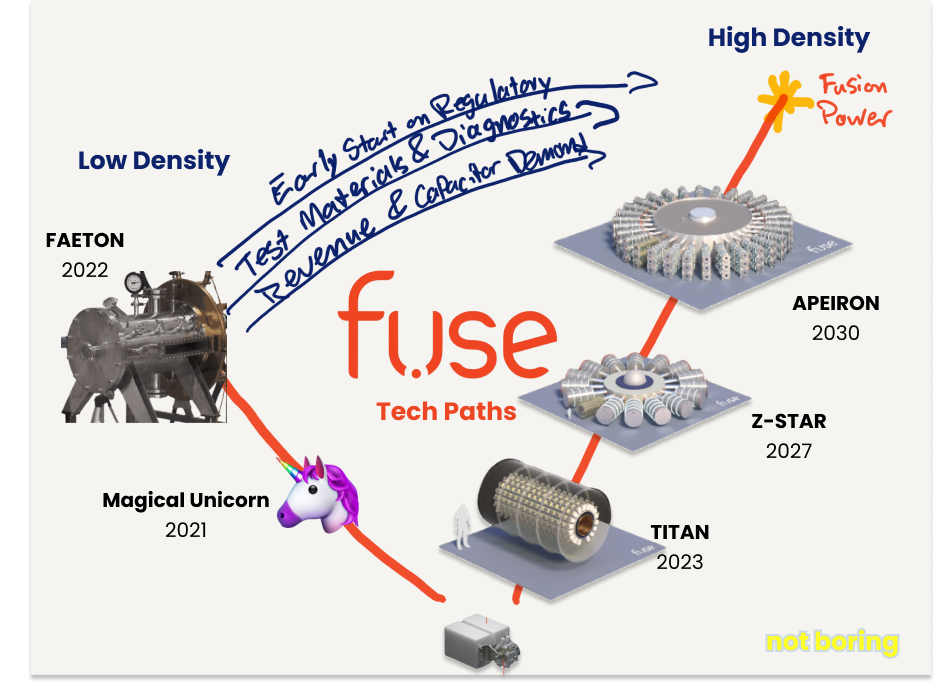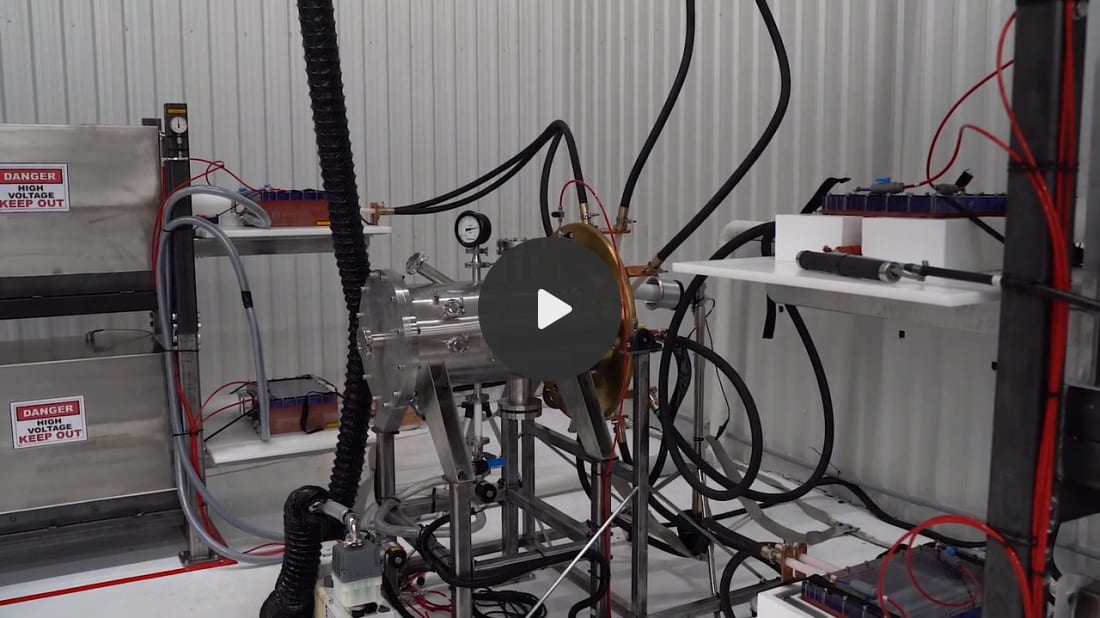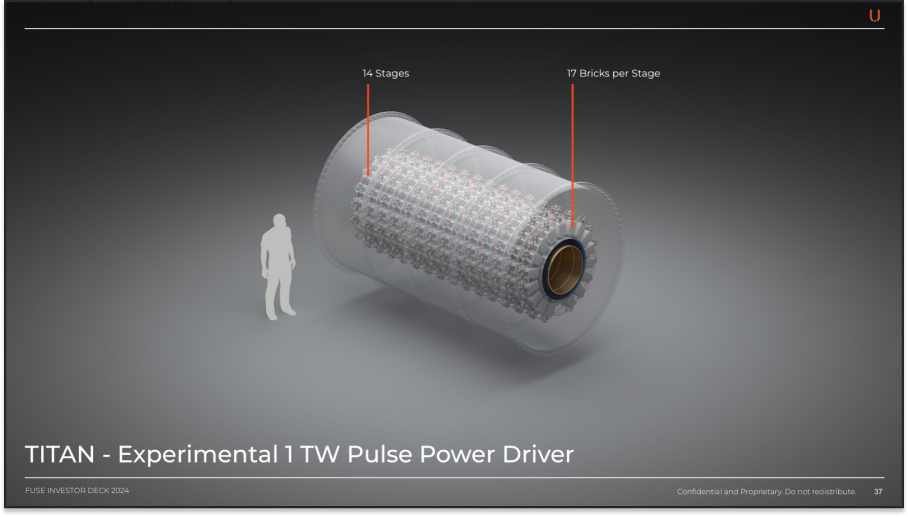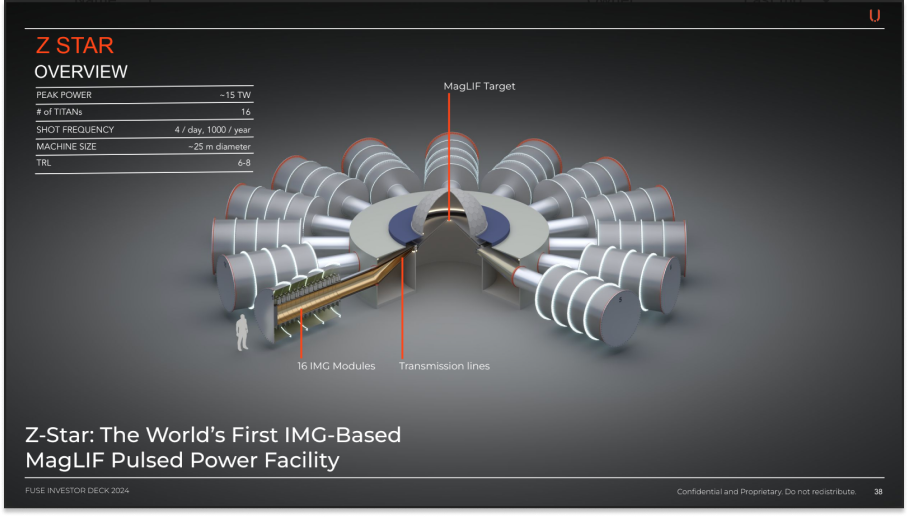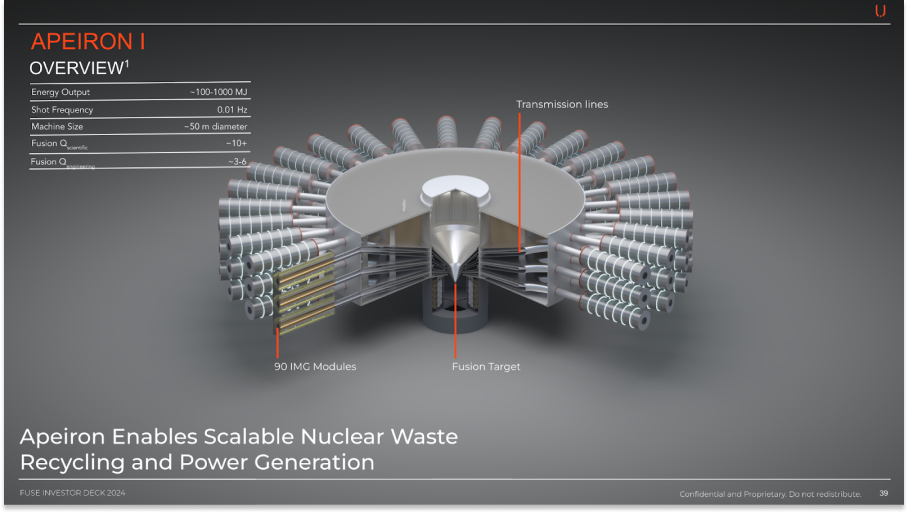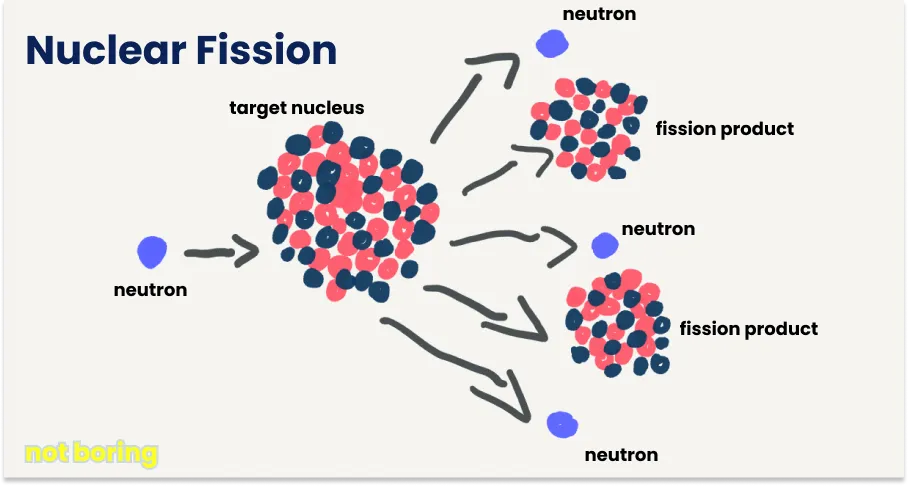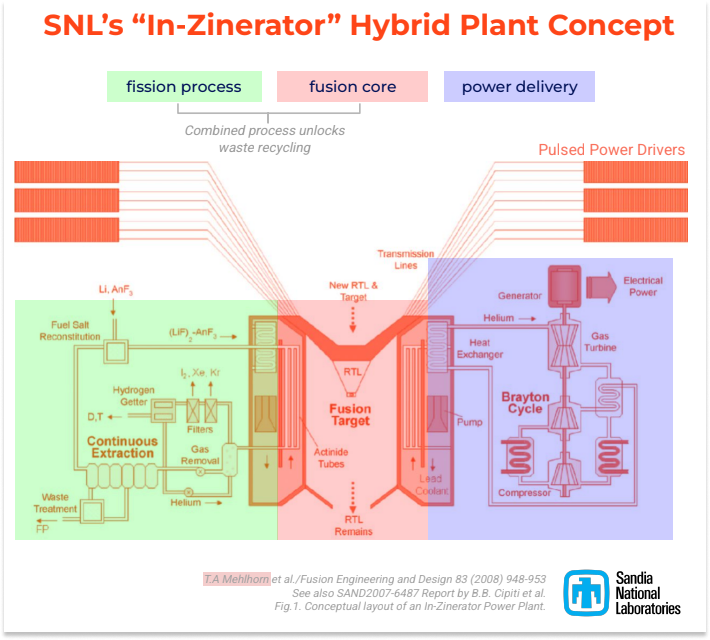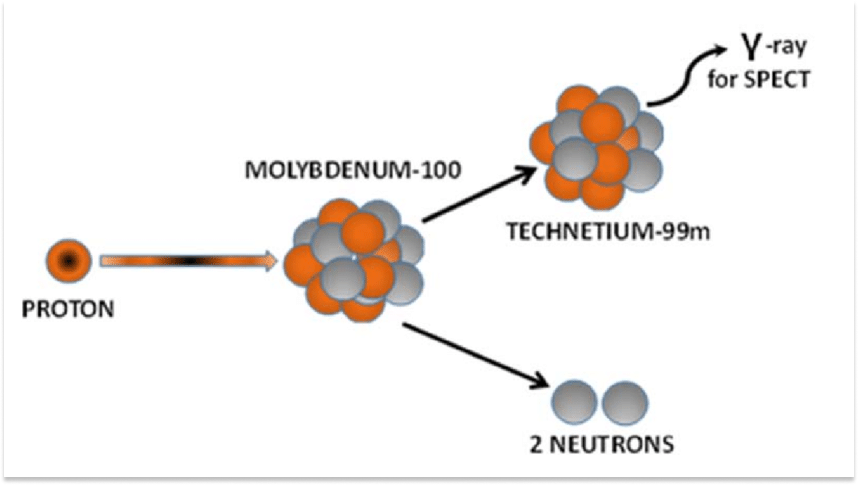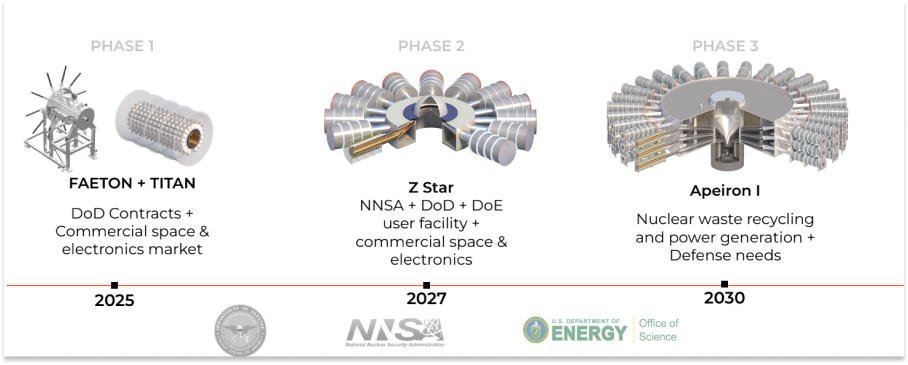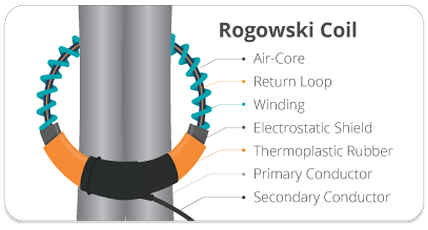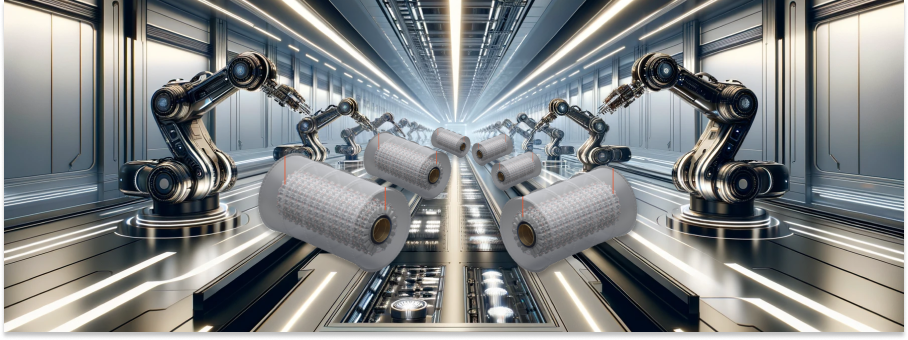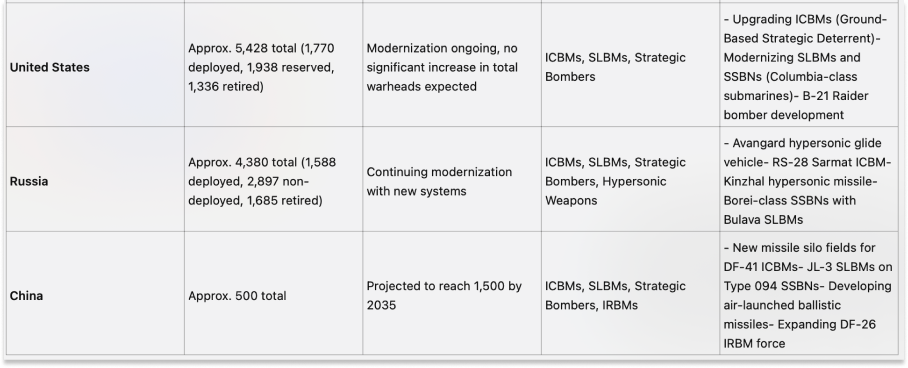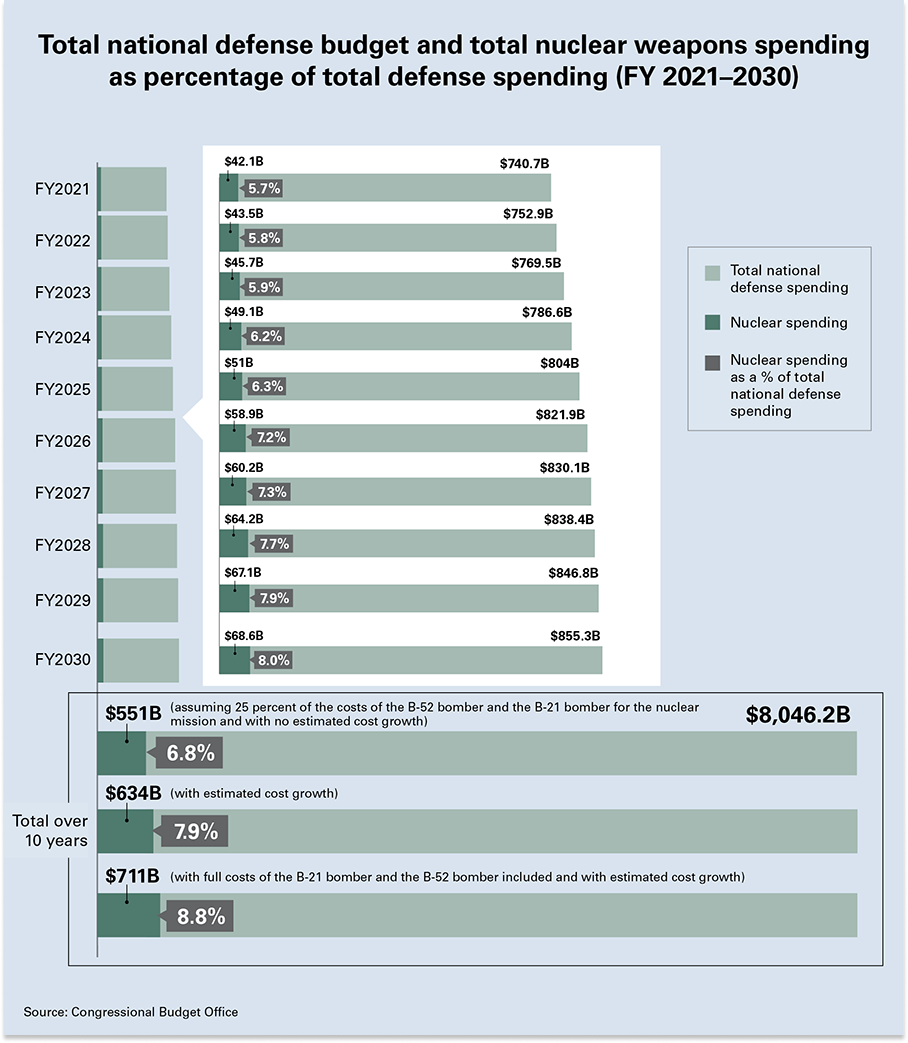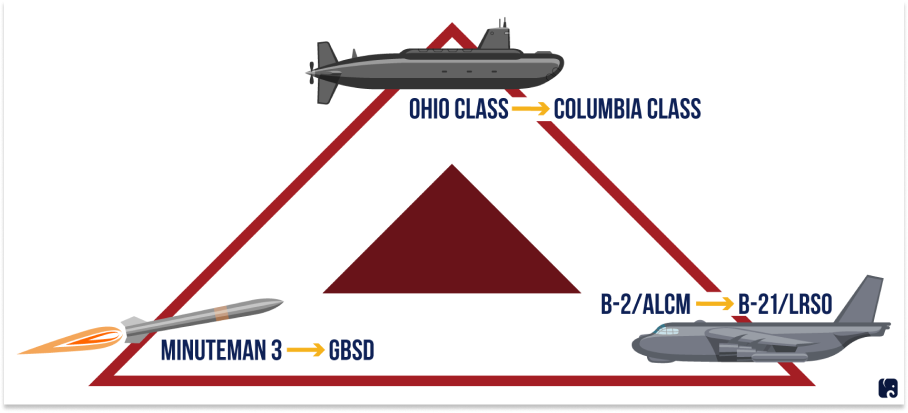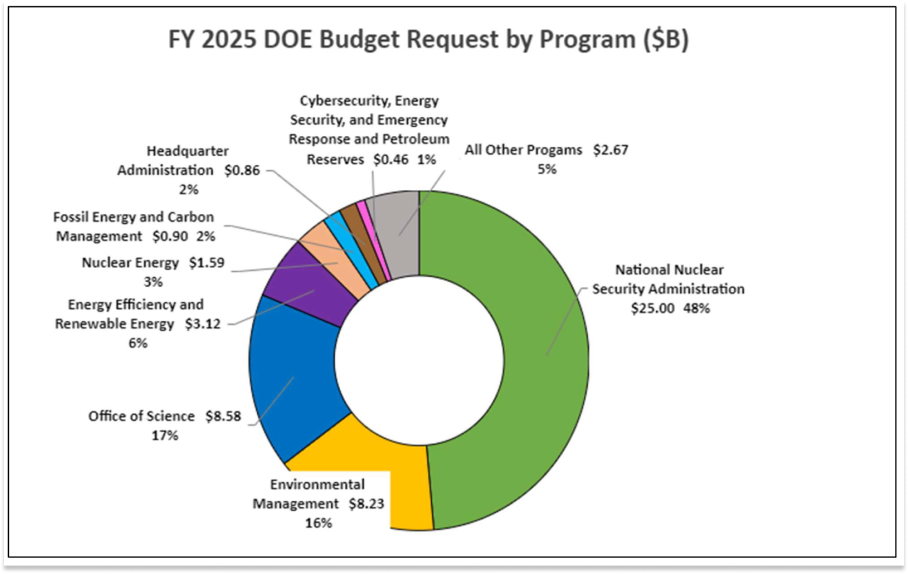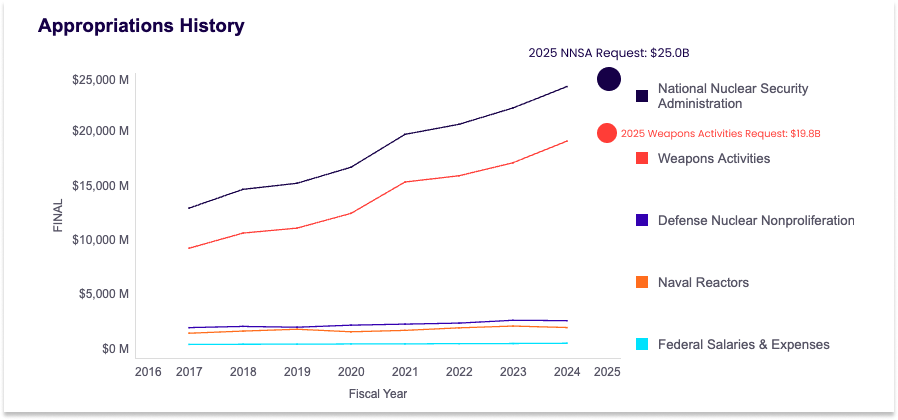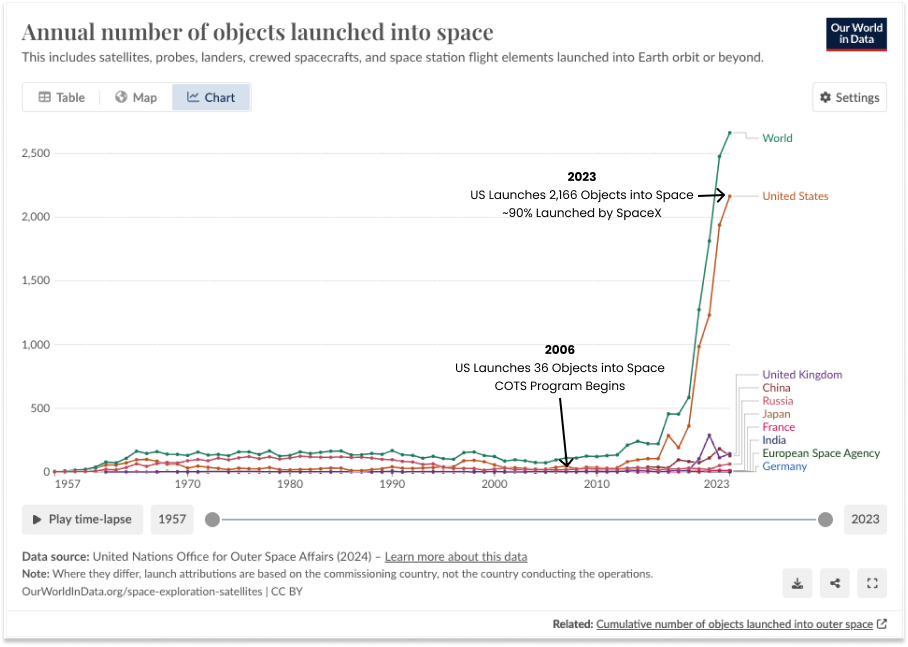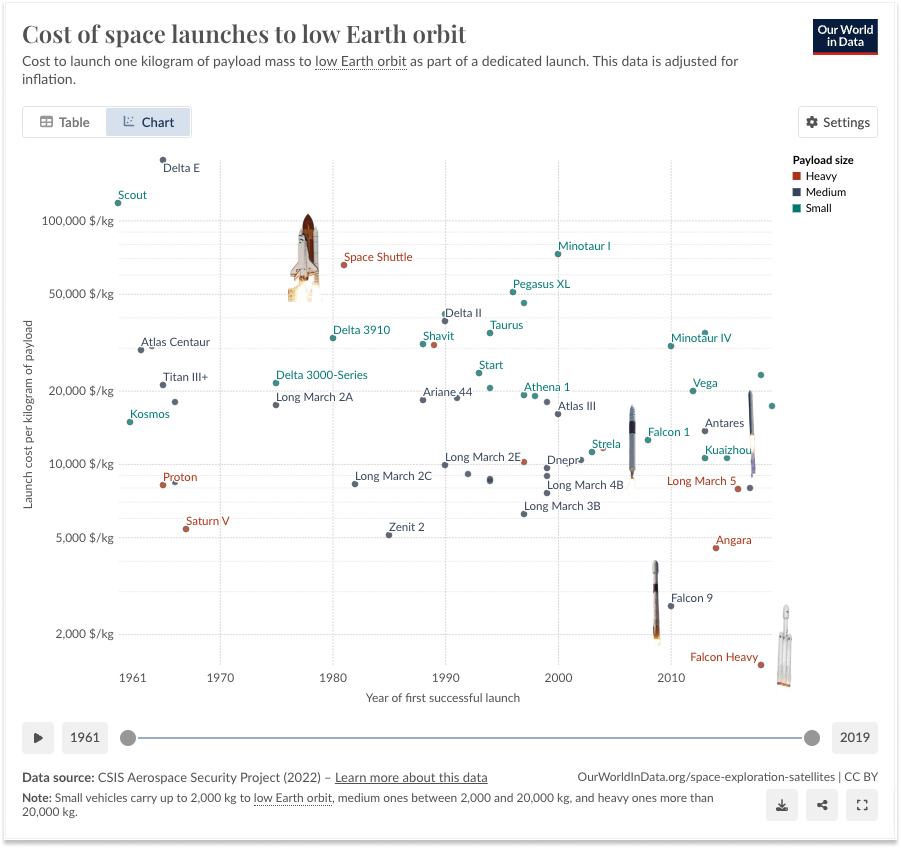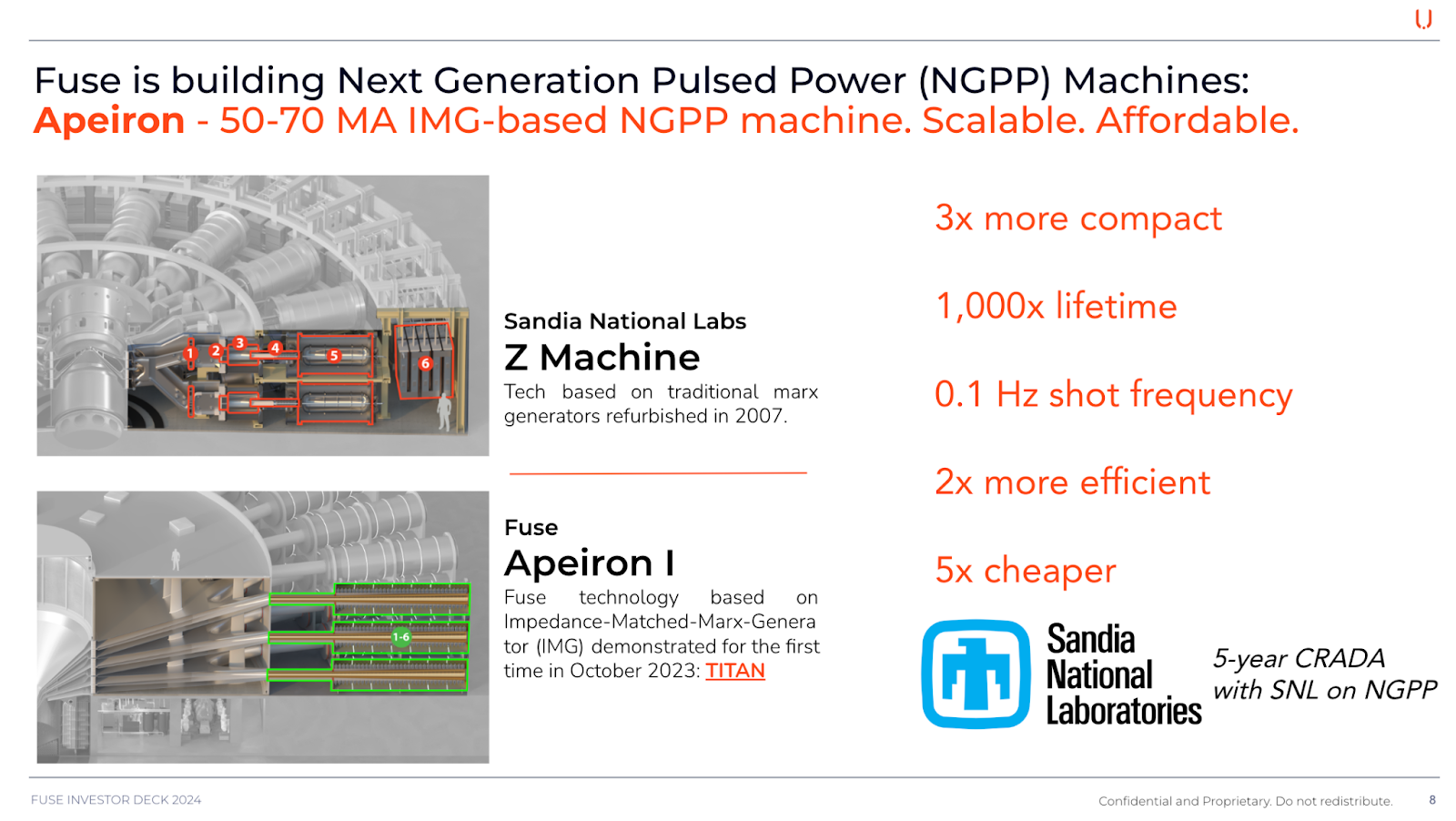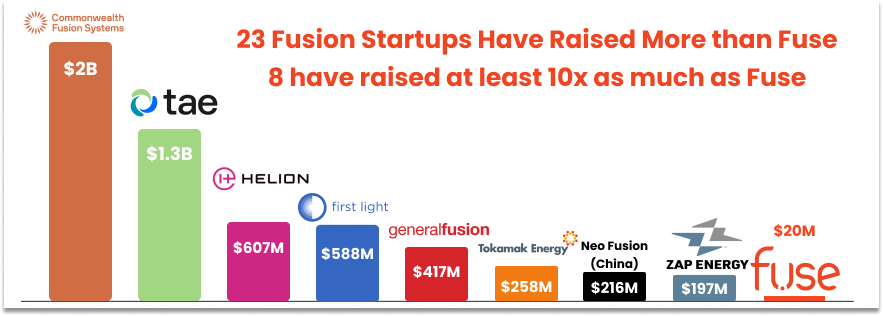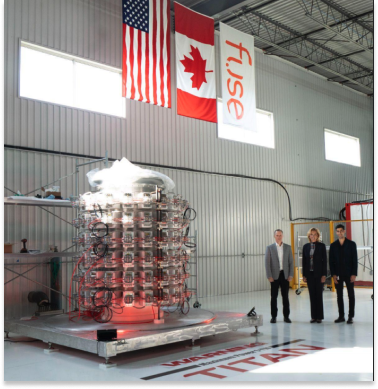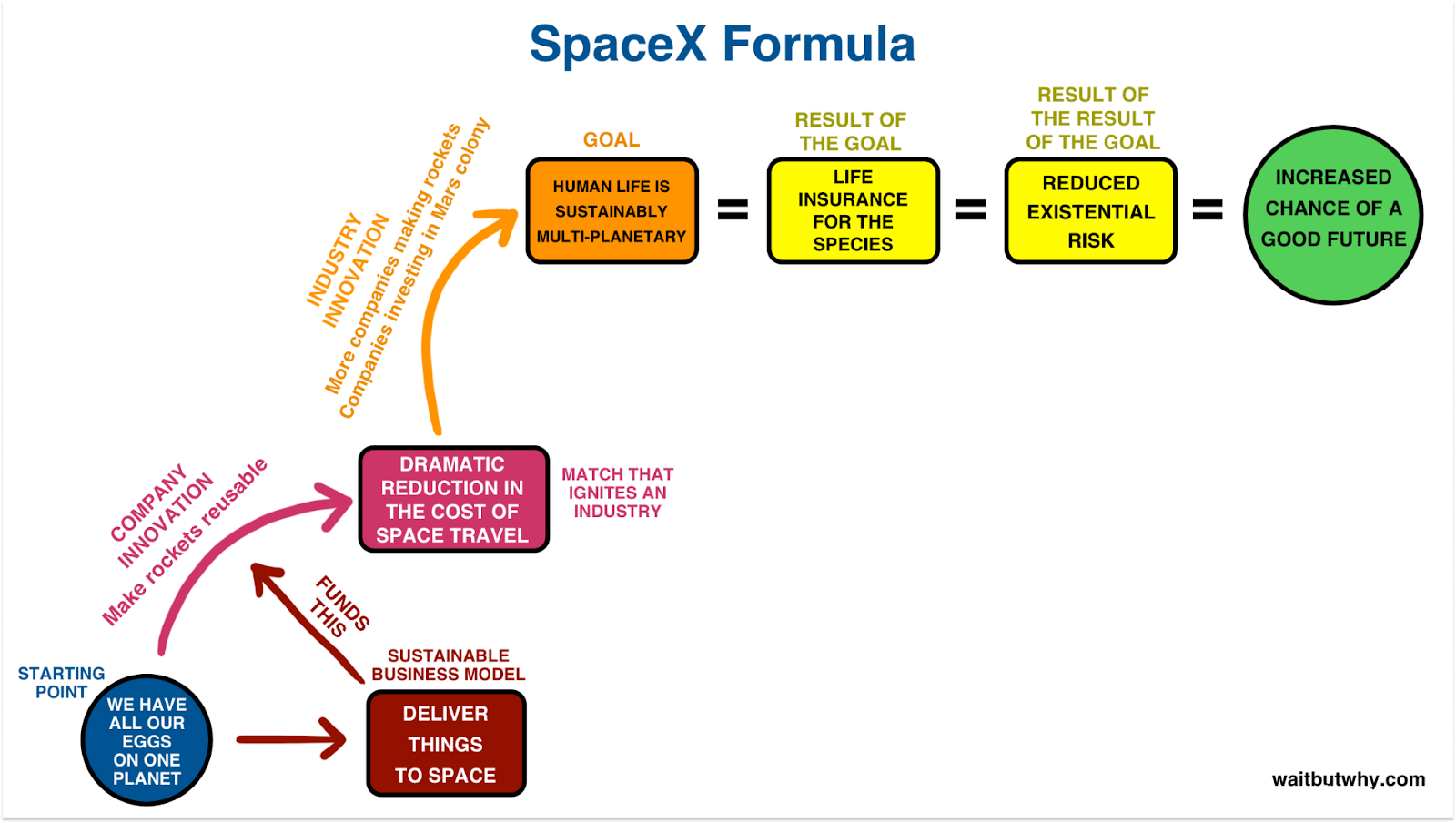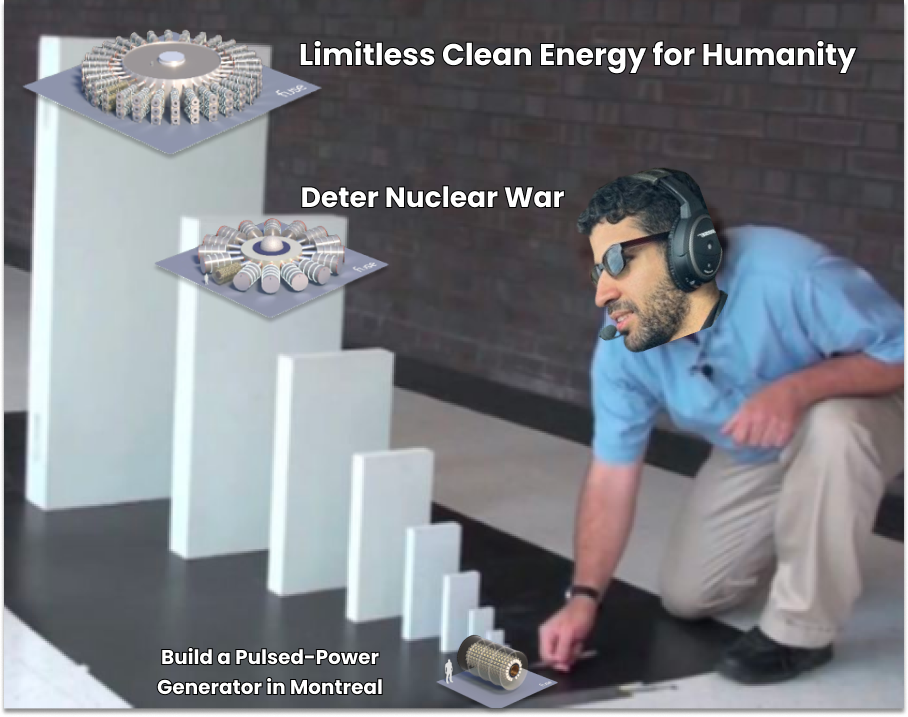Not Boring by Packy McCormick - Fuse Energy
Welcome to the 465 newly Not Boring people who have joined us since last week! If you haven’t subscribed, join 226,595 smart, curious folks by subscribing here: Hi friends 👋, Happy Thursday! We’re sending a couple days later than usual because Fuse wanted to check with their U.S. Government contacts before referencing some of their early government contracts and partnerships. It’s not often I get to write that. The subject of today’s Techno-Industrial Deep Dive, Fuse Energy, may be the most ambitious company you’ve never heard about. I think you’re going to be hearing a lot more about them in the coming months and years. Fuse is building pulsed power generators that can be used, in the near-term, for nuclear effects testing, and, in the long-term, to produce fusion power. It’s unique among fusion companies in that it’s building a business that can fund its journey to fusion, similar to SpaceX using launches and Starlink to fund its mission to Mars. We go deep on fusion, radiation effects testing, nuclear modernization, government budgets and more in this one in order to appreciate how Fuse’s plan fits together, and why I think it has the potential to be one of the Power Law winners I wrote about last week. Quick note on my bags: I’m not an investor in Fuse (sadly, yet), but after writing this piece, I would like to be. This one’s for the connoisseurs. I hope you take as much pleasure in figuring out how it all fits together as I did, and I hope that you can zoom out of the details for a second to appreciate how fucking cool it is that startups are tackling challenges at this scale. It’s a great time to be alive. To read the full piece online, head over to Not Boring. To read the one-page version, head over to Twitter (and share while you’re there!). Let’s get to it. Fuse EnergyThere may not be a company worth rooting harder for than Fuse Energy. If Fuse is successful, it will help avoid nuclear war on the way to delivering clean, abundant fusion energy. It might be our answer to The Great Filter. The Great Filter, proposed by Robin Hanson in a 1996 paper by the same name, suggests a potential resolution of the Fermi Paradox: if the probability that intelligent life exists somewhere else in the universe, why haven’t we met any aliens? Hanson’s idea is that there must be a stage in the evolution and expansion of life that is extremely difficult to surpass. Candidates include the emergence of life from matter, the transition from simple prokaryotic cells to complex eukaryotic cells, multicellularity, evolution of intelligent life, the ability to achieve technological advancement, surviving the technology we create (WE ARE HERE), and interstellar travel. The good news is that humanity has made it past a number of potential filters. We’re alive and intelligent and developing ever-more powerful technologies! The bad news is that, if it wasn’t impossible to make it this far, then maybe the reason we haven’t met any aliens is that they all destroy themselves once they get to this point. 😯 There are a number of ways we could destroy ourselves before expanding throughout the universe, but two of the most commonly cited are nuclear war and climate change. Nuclear war and climate change are existential risks to humanity. Fuse is working to mitigate both, through nuclear weapons effects testing and fusion power. And if it succeeds, it might ultimately help break that final barrier - interstellar travel – and fulfill the dream that got JC Btaiche interested in fusion in the first place. Man, I really don’t want to leave you hanging there, but before I tell you about JC’s dream, I need to impress upon you how different Fuse is from any other fusion company. For one thing, JC isn’t a PhD. He didn’t even go to college. He’s a 24-year-old Lebanese-Canadian immigrant to America who started Fuse in Montreal when he was 19. He’s attracted a team that includes:
I’ll tell you more about Fuse’s team and Advisors a little later, once we’ve covered enough to appreciate the relevance of their backgrounds, but they’re stacked. For another, Fuse recently became the first of the many startups pursuing fusion energy to actually generate revenue when it won a contract from the United States Air Force to provide nuclear testing and system hardening services. It turns out, depending on which generator design you pursue (Fuse is pursuing MagLIF), the first steps towards achieving Q>1, and ultimately commercial fusion power generation, are the same steps you need to take to generate the kind of radiation needed to do nuclear weapons and radiation-hardened electronics testing. The National Ignition Facility (NIF) at Lawrence Livermore National Lab, which made headlines in December 2022 when it achieved fusion ignition, is primarily used for such testing. It also turns out that there is both a massive need and a massive budget for such testing. Since President Clinton signed the Comprehensive Nuclear Test Ban Treaty in 1996, prohibiting underground nuclear explosions, the way America ensures that its nuclear arsenal actually works is by running simulations using data from high-powered radiation shots generated at places like NIF and Sandia National Labs, the home of the Z Machine. The National Nuclear Security Administration (NNSA), which is a semi-autonomous agency under the Department of Energy (DoE) responsible for the nation’s Stockpile Stewardship Program, has a $25 billion annual budget, as large as NASA’s. And like NASA did with its COTS program a decade ago, NNSA is now turning to public-private partnerships to modernize its nuclear testing capabilities. As SpaceX is to NASA, Fuse wants to be to the NNSA. Most fusion startups are trying to fly straight to Mars, so to speak, without launching satellites or building Starlink. They’re incredibly ambitious all-in bets on making commercial fusion a reality on the back of billions of dollars of funding, and I hope many of them succeed. Fuse is making a different, SpaceX-like bet: that it can build real businesses that both fund and accelerate its path towards commercial fusion energy. Former NNSA Administrator and Fuse Advisor, The Honorable Lisa Gordon-Hagerty, described the approach clearly: Fuse has “a viable pathway to commercial fusion with the ability to generate massive revenue through nuclear effects testing along the way.” To be clear, it’s a bet, with clear trade-offs. If you spoke to other fusion founders, they might say that fusion power is so important, and such a big prize, that any dollar or minute spent on anything not related to producing fusion power – on government sales, for example – is a distraction from that prize. But it’s a clear, logical, and differentiated bet, and one that might counterintuitively speed the route to commercially viable fusion power if it works. En route to fusion energy, Fuse plans to sell “Radiation-as-a-Service” to the NNSA, Department of Energy (DoE), and various branches of the Department of Defense (DoD) as part of its $1 trillion plan to modernize America’s Nuclear Triad. Like SpaceX, Fuse can use government money to offset the substantial development costs of machines that will ultimately power a massive commercial business, while simultaneously selling shots at software-like margins to both government and commercial customers. One of the things that drew me to Fuse, alongside the mission and JC himself, is that the business machine the company is building is as exquisite and precise as its fusion machines:
The business machine fits together so perfectly it almost feels as if it were pre-ordained, a gift from a cosmic entity who wants us to pass through the Great Filter. To understand how it all fits together and why Fuse may be able to pull off a goal that’s eluded so many brilliant people, we’re going to need to go deep. My hope is that by diving into the details, you’ll emerge with an appreciation for how beautifully the whole machine works. I’ve known JC for over a year and did a whole podcast season on nuclear fission and fusion, and I still had a few, “holy shit no way” moments writing this piece. We’ll cover a wide range of topics from fusion basics to nuclear weapons testing to the many uses of radiation. We’ll navigate government budgets and national labs. We’ll even do a little SpaceX comparison, which, by the end, might not seem as absurd as it sounds. What makes Fuse unique is that it’s trying to optimize for an entire system that predictably and profitably moves towards fusion power instead of optimizing for the platonic ideal of a fusion generator. Fuse’s generator design, customer needs, and business model are intricately linked; one stage flows into and funds the next. If it works, Fuse will be the rare capital efficient fusion company. But a plan is just a plan. While Fuse has made impressive progress, building three generators on time and on budget and signing government contracts in just five years on $20 million, it will have to build bigger and more powerful machines, run multiple interlinked businesses, and sell to a variety of customers, including various US Government agencies, to earn the right to sell fusion power. Like any great company, then, Fuse is a bet on the team. And that starts with JC. JC’s DreamThere’s this stereotype of a Great Founder. A genius, exposed to big ideas and adult conversations early in life, who shows early entrepreneurial signs by building a small business at a young age. A precocious outsider who faces some sort of adversity that builds resilience and some critical skill, driven by a burning mission. Most founders don’t actually fit the stereotype perfectly. JC Btaiche kinda does. In some ways, JC was like a lot of kids. He dreamed of being an astronaut. In practically every other way, he wasn’t. Born in Saudi Arabia, JC moved to Lebanon when he was little, where his nuclear physics-trained father pursued his career as a plant manager building manufacturing facilities. When he was just seven years old, his eighteen-year-old brother set up a gaming lounge with four computers on the floor of a building in their village, and JC helped out. When his brother left for Canada the next year, eight-year-old JC took over the business. He hosted Counter-Strike and Dota tournaments, sold crepes and hot dogs, and attracted paying customers from as far as an hour away. When money came in, he used it to buy new computers, scaling from 4 to 32 during his time at the helm. “It was a full business,” he said, “It was a large part of the family’s income.” At night, dinner conversations with his nuclear physicist father sparked JC’s interest in understanding how the universe worked. Not in a superficial or theoretical way. He wanted to be an astronaut because he wanted to go see the universe for himself, to prove that what people said about it was actually true. Imagine little JC’s disappointment, then, when his father told him that no human has actually ever traveled further than the moon, and that it wasn’t quite possible to do so. So he started Googling. He learned that the only reasonable possible way to do it would be to build fusion drives to power rockets. So he Googled fusion, fusion drives, fusion powered rockets, and he realized he really wanted to build one. JC came to fusion to solve the last of the Great Filters – to make interstellar travel a reality – but even as an early teenager, he was practical about the problem. He didn’t just want to dream about fusion-powered interstellar travel, he actually wanted to make it happen, so he started charting a long and practical path to get there. Humans hadn’t even figured out how to use fusion to generate power on earth yet, he learned, let alone to power interstellar travel. So despite the fact that JC didn’t like school, fusion motivated him to sit in a classroom and pay attention in order to nail the basics. Outside of the classroom, he kept researching fusion. At just 16-years-old, JC got a research internship at the American University of Beirut, where he “researched the mysterious hexagon on the pole of Saturn in the fluid dynamics and plasma laboratory under the supervision of Professor Ghassan Antar,” according to his LinkedIn. It was heady stuff for a 16-year-old, but it also made JC realize that while he could do fascinating science in Beirut, “the West is where things get built.” So one day, he decided he was going to leave Lebanon and join up with his brother in Montreal, Canada. He booked the ticket that day and left a week later. In Montreal, without his parents and friends, JC got to work doing interesting things in order to meet interesting people. He built a hoverboard company – HoverX – that went under due to the price of lithium-ion batteries. He started a non-profit – Hestia Academy – to bring together insanely talented teenagers who wanted to work on real problems, not just lemonade stands. As he explained on the Space Talks podcast, he started Hestia because he was deeply disappointed by the startups he met at a university accelerator in Montreal:
He was right. The first cohort, funded in part by Google and Shopify, included three teams of teenagers solving hard challenges: a $1,000 Brain Scanner, an algorithm for early breast cancer detection, and a device for the visually impaired. As if to prove through sheer effort that teenagers could do more than people thought, somehow, while running Hestia and attending high school, JC also pursued research on multi-agent research learning under the supervision of Professor Steve Liu at McGill University. That’s as close as he got to university, though. Instead of attending college after high school, JC decided that the fastest way to learn, make progress, and impact the field would just be to get out there and start a company. So that’s what he did. In 2019, at age 19, JC founded Fuse Energy. It’s tempting, and usually too simplistic, to draw straight lines from adolescent experiences to something that someone did later in life. But given that JC started Fuse at 19-years-old, you don’t need to draw a very long line to connect his childhood to the company. There are the obvious ones:
But there are less obvious parallels, too. Like the idea of breaking down the really big, far out goal into approachable chunks. Fuse is one of the only fusion companies that’s not racing directly to electricity as its first product. Or the blend of theoretical science and practical engineering that JC’s dad - both nuclear physicist and manufacturing plant manager – infused into JC’s, and therefore Fuse’s, DNA. Or the belief that school can corrupt your mind, apparent in the way JC chose which generator design Fuse would pursue. Or the idea of reinvesting cash flow into growth, learned in the video game cafe business and now applied on a much larger scale. Or, most subtly, the idea of coming into a new place and attracting the best people from a wide range of backgrounds through shared interests and a bold mission. All of these themes will appear throughout this piece. They’re core to how Fuse is building. And they influenced how JC chose what to build in the first place. The Z Machine RebornOne of the underappreciated benefits of not having a degree, particularly an advanced degree, is that you're not tied to any particular line of research. In academia, you don’t choose your research based on which design is potentially most commercially viable. The fusion research that’s most interesting to study in the lab may not make for the best business. By not going to college, let alone getting his PhD, JC had a clean slate when deciding which generator design to pursue at Fuse. To make that decision, he spoke to a number of academic researchers, each of whom believed that the approach they had pursued in the lab was the right approach and that it was time to spin out. There are currently dozens of brilliant teams building fusion startups pursuing every conceivable generator design, many of which they’d studied for years before going commercial, but none of them seemed to be asking the question that JC thought was most important: “Where is the government spending billions of dollars already?” That question led him to the Z Machine at Sandia National Labs. The Z Machine is the most successful nuclear program that no one has heard of. When Rahul Rana and I wrote The Fusion Race, we didn’t mention it. Its sister machine, the National Ignition Facility at Lawrence Livermore National Lab (NIF), gets all the headlines. But the Z Machine sports an impressive list of superlatives:
Like NIF, Sandia’s Z Machine was not designed to produce fusion power. Both were built for nuclear weapon stockpile stewardship and research into fusion and high energy density physics. But NIF and Z Machine share a common mantle on the path to commercial fusion: they’re the only two machines that have achieved the triple product of 1020 KeV s/m3, within the order of magnitude required for scientific breakeven (NIF has achieved it, Z has not yet). If you’re going to try to produce fusion power, JC thought, why not pursue one of the two paths that’s already generated the conditions necessary to do so? So JC decided to build a pulsed-power generator en route to a MagLIF generator, like Z Machine. But he didn’t just do it because Z did; it turns out, pulsed power is a fruitful commercial path to fusion, too. To understand why – and terms I just threw at you like “triple product” – we’re going to need to do a little refresher on how fusion works. Fuse-Specific Fusion RefresherFusion is a miracle. It’s how our Sun and all of the stars in the universe produce energy, and it’s humanity’s path to practically limitless clean energy. I’ve covered how fusion works a few times, and I don’t want to rehash it all here, so if you want to go deep, check out The Fusion Race and our Age of Miracles episode on the topic: 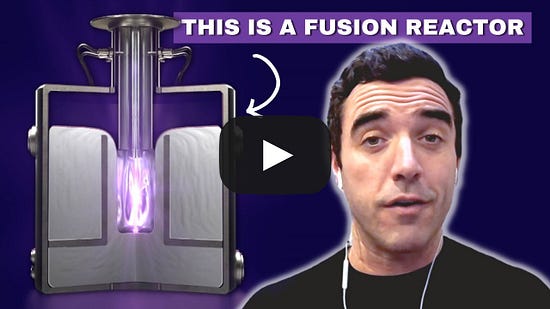 For our purposes, I’ll borrow from both but stick to the most relevant pieces for understanding Fuse’s approach. You might be tempted to skip this section, and you can! There’s much more ahead! But thinking through all of this is what made Fuse really click for me. It was the a-ha. So fusion… How Fusion Works and What It ProducesIn fusion, two light nuclei, typically the hydrogen isotopes deuterium and tritium (D-T), merge to form a single heavier nucleus. The process releases energy because the total mass of the resulting single nucleus is less than the mass of the two original nuclei. The leftover mass becomes a tremendous amount of energy in the form of neutrons, per Einstein’s famous formula: E=mc2. In the D-T fusion reaction, the neutron carries away most of the energy released, approximately 14.1 MeV (million electron volts). These high-energy neutrons can be used for various purposes, like generating heat for electricity production or even for material testing. If you’re familiar with fusion and largely think of it in terms of clean, abundant energy, here’s a little mental shift that’s helpful in understanding what Fuse is doing: High-energy neutrons are the product of D-T fusion reactions. One application of those neutrons might be electricity production, but there are other valuable ways to use those neutrons. Hold that thought. Fusing two atoms together is hard, primarily because of electrostatic repulsion. Atomic nuclei are positively charged because they contain protons, and repel each other similar to how magnets of like poles repel each other. This, incidentally, is why light atoms make the easiest fusion fuels: fewer protons, less electrostatic repulsion. Fusion needs a controlled environment of more than 100 million degrees Celsius and as dense as the core of the Sun for long enough for the reaction to ignite. These three parameters – density, temperature, and confinement time – make up the “triple product.”
In order for a fusion reaction to reach ignition, or become self-sustaining, the triple product needs to reach a certain threshold, at least 1020 KeV s/m3. Different generators attempt to clear that bar by optimizing the triple product variables in different ways. Magnetic confinement fusion systems, like tokamaks and stellarators, strive for confinement times on the order of seconds to minutes at high temperatures but low densities. Inertial confinement fusion systems, like NIF, have confinement times measured in nanoseconds, but make up for lost time, as it were, with higher temperatures and densities. Fuse’s Generator of Choice: MagLIFFuse is pursuing MagLIF, or Magnetized Liner Inertial Fusion, which falls somewhere in between magnetic confinement and inertial confinement on the spectrum of triple product optimization. MagLIF uses a self-induced strong magnetic field – created with a high electrical current as opposed to super strong magnets, like Commonwealth Fusion Systems uses – to confine and compress a preheated and magnetized fuel, typically deuterium-tritium, within a metallic liner. The liner is then rapidly imploded using a powerful electrical current, further compressing and heating the fuel to fusion conditions. 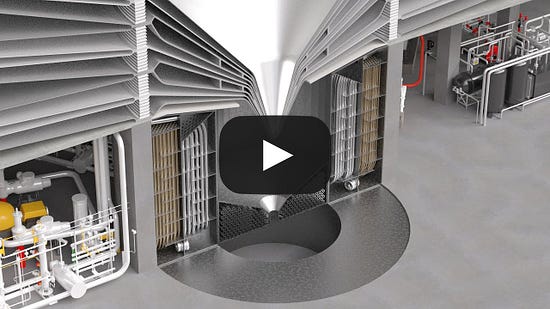 By borrowing pieces from each approach, eliminating inefficiencies, and avoiding extremes, MagLIF has the potential to be 10x more efficient and less than 10% the cost and size of laser-driven inertial confinement generators like NIF. That’s a bold statement that has been peer-reviewed in Fuse’s publication in the tier-1 scientific journal, Vacuum. Compared to a tokamak like the multinational ITER project, MagLIF can be less than 5% of the cost. The Z Machine itself is not a MagLIF fusion generator. It’s a pulsed power generator that can run MagLIF experiments. A pulsed power generator charges capacitors – think of them like batteries – over a relatively long period of time and then releases the stored energy very quickly in the form of a high-power pulse. Those pulses shoot a tremendous amount of current – Z does 26 megaamps (MA) – at the target in a very short amount of time. In MagLIF experiments on the Z Machine, the target is a cylindrical metal liner containing a preheated and magnetized deuterium-tritium fuel. In this process:
Pulsed-power generators are the critical component of MagLIF generators, and capacitors are the critical component of pulsed-power generators. There are other important components, but I’ve thrown a lot at you already, and that’s the simplest way to think about the pulsed power generators Fuse is building. The performance of pulsed-power generators, and therefore MagLIF generators, is largely determined by the capabilities of capacitors used, along a few dimensions:
Roughly – and again, there are a number of other factors, but roughly – as capacitors improve, MagLIF generators are more likely to achieve Q>1, or breakeven, to get more energy out of the fusion reaction than is put into it, and then Qcommercial>1¹, or commercial breakeven, when it can make more money from selling power than it costs to produce it. Q, the ratio of energy output to energy input, is related to the triple product, but it’s not the same thing as the triple product. You can achieve a super high triple product without achieving Q>1 by dumping a ton of energy into the process, but you cannot achieve Q>1 without a triple product greater than 1020 KeV s/m3. Achieving that triple product is necessary for self-sustaining fusion, but it’s not sufficient. If you’re willing to pour more energy into a process than you get out – say, because you want to run tests to ensure that America’s nuclear stockpile still works – you can use fusion to produce radiation before you can achieve Q>1, or Q> whatever you’d need to profitably produce electricity. Roughly, the higher your triple product, the more radiation you can produce. Radiation Can Be Good, ActuallyIn the public consciousness, radiation is a dirty word. It brings to mind Chernobyl and radiation poisoning. But radiation is simply the emission of energy as electromagnetic waves or particles. Neutrons are radiation in the form of particles, and X-rays and gamma rays are radiation in the form of high-energy electromagnetic waves. Too much of the wrong types of radiation in our bodies is bad, but radiation powers the world. The sun’s rays, for example, are radiation in the form of visible light, ultraviolet light, and infrared radiation. Radiation is energy. Properly harnessed, radiation is good and valuable. And controlled fusion can produce properly harnessed radiation, which many customers are willing to buy. This is why Fuse is pursuing MagLIF, starting by building modern pulsed-power generators. The MagLIF path can generate revenue at high margins by producing valuable radiation in the form of neutrons, x-rays, and gamma rays at relatively low costs, while it both rides and drives down the cost curve of components like capacitors, en route to fusion energy. Eventually, Fuse believes that cheaper and more performant capacitors will lead to cheaper and more performant pulsed-power generators which will lead to MagLIF generators that produce more energy from fusion reactions than is put into those reactions, profitably. Fusion power baby! Now, with a little physics under our belt, we can turn to what Fuse is building. What Fuse is BuildingFuse is building the modern Z Machine, both because it’s one of the most proven paths to fusion power and because it offers the opportunity to sell radiation-as-a-service on the way to abundant energy. In other words, building pulsed power generators lets Fuse monetize radiation at Q<1 on the path to Q>1. While a stellarator may be a more elegant fusion power generator in its ideal state, Fuse is optimizing for a blend of science, engineering, and business that it believes will actually get the company to the fusion end state sooner. And it can use all of the work that the government has done on the Z Machine to give the company a head start. The Z Machine is a wonder of scientific and engineering achievement, and it is old. First constructed in the early 1980s as the Particle Beam Fusion Accelerator, it was revamped and renamed the Z Machine in 1996, and most recently revamped in 2007 to increase its power and efficiency with enhancements to its capacitor banks and switches. When JC discovered the Z Machine in his research, it was like he’d uncovered a secret hidden in plain sight. No private company was pursuing anything like the Z Machine, despite its performance and despite the fact that researchers in the field had laid out a very clear roadmap for the next generation of the Z Machine. When he spoke with people in the government or the fusion research community, everyone told him “Oh, we know we need to build this, but it’s taking a lot of time” or “We’re just trying to get the budget and approval.” Whatever the excuse, they knew it worked and weren’t building it. To the right kind of entrepreneur, one willing to tackle both the physics & engineering and government-navigation challenges necessary, that’s music. That’s a golden ticket. “So,” JC said, “we just went and built it.” To build the next generation of Z Machine, though, you don’t start by building the next gen Z Machine. Instead, Fuse is building a series of progressively larger and more powerful machines, each of which can generate profits by selling radiation-as-a-service, and each of which contributes to improving the performance and lowering the cost of critical components like capacitors and switches. As we go through Fuse’s technology, keep in mind that radiation can do a lot of useful things – from nuclear effects testing to enabling nuclear fission – even before they achieve a self-sustaining fusion reaction. Like a farmer that uses every part of the cow it slaughters, Fuse sells every capability of the radiation it produces. In fact, the best way to think about Fuse’s business is that it sells radiation that can do increasingly valuable things the more powerful its machines get. Building Up to Z, Brick by BrickIt starts with the Brick, the high-voltage capacitor and gas switch that is the fundamental building block of its pulsed power generators. In a pulsed-power generator, multiple capacitors are charged in parallel to a high voltage. When it’s time to fire a shot, a trigger closes all of the switches, reconfiguring the capacitors from a parallel arrangement to a series arrangement. In a series arrangement, the voltages of the individual capacitors add up, so if each capacitor is charged to 100 volts and there are 10 capacitors, the total output voltage becomes 100 x 10, or 1000 volts (1 kV). That pulsed power can be used to implode a solid liner (with more current) or to create high electric current that creates a magnetic field around a gas, compressing it into a plasma (with less current). The inward force of the magnetic field increases the pressure and temperature of the plasma – this is known as the pinch effect – which can theoretically create conditions suitable for nuclear fusion. Initially, Fuse pursued this path, attempting to build towards a Z-pinch generator. In December 2021, it fired up its first fusion generator: Magical Unicorn (MU) “the world’s most advanced low density flow through Z-pinch.” The “low-density” here refers to the gas, as opposed to “high-density,” where the magnetic field compresses a solid fuel-filled liner. Magical Unicorn generated 0.5 MA of current, produced Fuse’s first neutrons, and fired more than 3,000 “shots.” As JC told the Canadian Nuclear Society (CNS) in June 2022, while the MU generated 10+ filed patents, demonstrated novel plasma injection technology, and validated important subsystem components like capacitor banks, gas mixing, and plasma sources, it also showed the team the limitations of low density Z-pinch generators. They could produce a lot of neutrons, but it was hard to see a path for them to produce fusion power. While the team realized that gas-based z-pinch wouldn’t scale up to fusion power, the patents and technology that the team developed for MU were useful on the fusion path, and in-demand in the radiation testing community. So JC decided to leverage gas-based z-pinches for the radiation testing community but focus on liner-implosion as the path to fusion power. The FAETON PathOn the low density path, Fuse worked towards a product that would be valuable for radiation testing even if it wouldn’t lead to fusion power. In September 2022, the Canadian Nuclear Safety Commission (CNSC) gave Fuse its official license to operate, the first it had given to a private company. The next month, in October 2022, Fuse launched its second generator: FAETON I. FAETON I is a fusion generator designed as a dense plasma focus (DPF) device. It’s the more powerful successor to MU, generating 1.2 MA of current versus MU’s 0.5 MA. More current, more neutrons. In one shot, FAETON, which cost only $5 million to build (before Canadian government subsidies, which covered 75% of salaries and 30% of material costs), can create more neutrons and X-rays than facilities that cost over $1 billion to construct. In May 2023, the CNSC updated Fuse’s license to allow for a higher neutron yield: 1013 neutrons per year, giving FAETON I the highest neutron output per year in Canada. While not directly on the path to fusion power, FAETON is a great business that simultaneously contributes to the company’s progress in fusion. The company can sell radiation-as-a-service on FAETON for use in radiation-hardened electronics testing, nuclear weapons testing, and neutron detection. Combined, FAETON serves an undersupplied market with a $5.2 billion TAM at gross margins of over 90%. Fuse is already generating revenue on FAETON I. At the same time, FAETON can speed up Fuse’s path to fusion power on the high density path. It contributes cash flow that can fund development, creates nuclear and radiation environments that allow Fuse to test materials and diagnostics for fusion, drives improvements in the Brick, and gives the company an opportunity to get started on the regulatory path earlier. Fuse is now developing FAETON II in the United States. We’ll discuss it more in the next section. For now, let’s turn to high density. The TITAN PathFor Fuse, the path to fusion power goes through TITAN, the company’s 1-TW Impedance-Match Marx Generator (IMG), a specific type of pulsed power generator designed to efficiently transfer energy by matching the electrical resistance (impedance) between the generator and the device it’s powering. TITAN is both made of building blocks (Bricks) and is a building block (for Z STAR and APEIRON). TITAN I is composed of 238 Bricks – 14 Stages with 17 Bricks per Stage. It can reach a peak current of 0.8 MA and a peak voltage of 1.6 MV. It’s the world’s first and highest-power pulsed power driver of its kind. In October 2023, just four years into the company’s life and on the back of a relatively small $7.1 million spring 2023 fundraise, Fuse fired TITAN I for the first time. 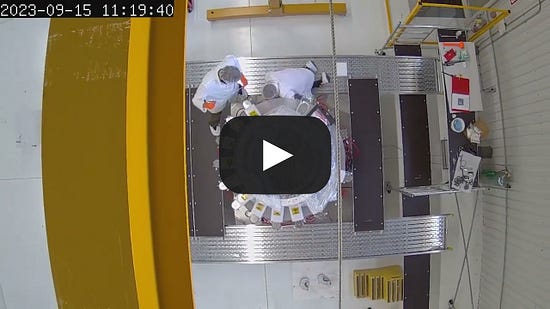 TITAN I is a vast improvement over the state of the art pulsed power generators. According to Fuse, it’s 3x more compact, has a 1,000x higher lifetime, is 2x more energy efficient, and at least 5x cheaper than current pulsed energy drivers. The company showed the world’s first experimental results for over 100 consecutive shots of an IMG, and submitted the results to Nature Scientific Reports for peer-review. One of the co-authors on the paper is Dr. Rick Spielman, the former Chief Scientist of the Z Machine and a leading expert in pulsed power. TITAN will be used as a building block for future Fuse machines, and as a source of radiation for testing in its own right. While it won’t produce neutrons – it’s 0.6 MA isn’t a strong enough current to implode a liner – it will produce radiation. It can be connected with a Bremsstrahlung source to produce hot x-rays for hostile nuclear effects testing or with an electron beam source for electron beam testing. After proving out the TITAN I and FAETON I prototypes in Montreal, Fuse is opening up a US headquarters in San Leandro, California, where it will build TITAN II and FAETON II with a fully US-compliant supply chain in order to sell shots to the government. Even with the US-compliant supply chain, these generators will cost Fuse in the single-digit millions, a portion of which it hopes the government will cover. Each shot these machines fire is worth tens of thousands of dollars to customers at ~90% margins to Fuse, it can fire as many as 50 in a day, and given undersupply, demand shouldn’t be an issue. As such, paybacks may be well under one year. Over time, the economics may get even better. If TITAN I was the prototype, TITAN II will be built for scale, for a couple of reasons. First, which we’ll discuss a little later, because Fuse may sell TITAN IIs to other fusion companies. And second, because Fuse’s own future machines – Z STAR and Apeiron – will need a lot of TITANs. Z STAR, the mid-scale pulsed power facility Fuse plans to launch in 2027, would consist of 16 TITANs in a ring, shooting all of their power at one MagLIF target in the center (likely D-T fuel). The Z STAR will have a peak power of roughly 15 TW. Compared to FAETON’s 1.2 MA and TITAN’s 0.8 MA, Z STAR will deliver 12.8 MA of current. Whereas capacitors’ voltages add up in a series arrangement within a TITAN, all of the TITANs’ currents add up in Z STAR since they’re connected in parallel. Delivering 12.8 MA of current is an important milestone, because it takes at least 10 MA of current to implode a liner and produce neutrons. Z STAR will produce “1014 D-T,” or 100 trillion deuterium-tritium reactions. Since each D-T reaction produces one neutron, Z STAR will produce 100 trillion neutrons per shot. Z STAR is an intermediate step towards Fuse’s creation of a next gen Z Machine, or Next Generation Pulsed Power (NGPP) Machine. As JC described it to me, just as the Laboratory of Laser Energetics’ OMEGA facility at the University of Rochester (where Dr. Spielman works) serves the laser community as an intermediate facility to NIF, Z STAR will serve the pulsed power community as an intermediate facility to the Z Machine. And like OMEGA, Z STAR will likely be housed at a research university. Fuse is currently in talks with one in particular which would provide the building to host Z STAR, a $30 million value. Fuse currently expects to have Z STAR online in 2027. If Z STAR is an intermediate step, APEIRON I is the destination. APEIRON I is a planned 50-70 MA machine that would serve as Fuse’s first fusion pilot plant. Instead of Z STAR’s 16 TITANs, APEIRON I will stack 90 modified TITANs. And instead of producing neutrons mainly for testing, APEIRON I will produce neutrons mainly for power generation. Specifically, Fuse is planning to build APEIRON I as a hybrid fusion-fission generator. In 2007, Sandia researchers wrote a paper, The Role of Z-Pinch Fusion Transmutation of Waste in the Nuclear Fuel Cycle, that showed that hybrid fusion requires Q far lower than 1 to produce power. One of the paper’s authors, Dr. Tom Melhorn (who’s also highlighted in the In-Zinerator graph below) is now working with Fuse as an Advisor. Remember that neutrons are very versatile particles. One of the things that neutrons can do is set off nuclear fission. In a typical fission reaction, the goal is to set off a chain reaction. Plant operators insert fuel rods containing fissile material – typically uranium-235 or plutonium-239 – into the reactor core and then activate a neutron source – like polonium-beryllium – to begin the process. The starter neutrons hit the uranium atom, splitting it into two smaller atoms and a neutron, which flies off and hits another uranium atom, which splits and releases a neutron which hits another uranium atom, and so on. This is called going critical. In these reactions, the neutron source is just a kickstarter – it does its job, and then the chain reaction takes over. But what if you had a way to consistently produce high-energy neutrons? Fuse will. Its scheme is subcritical by nature because it relies on the fusion reaction to continue producing neutrons, and therefore has none of the criticality concerns associated with traditional nuclear fission reactors. In a hybrid fusion-fission reactor, like Apeiron, the D-T fusion reaction in the core releases high-energy neutrons and large amounts of energy. Those neutrons fire off and hit a fission blanket surrounding the core, typically made of heavy atoms like uranium and, importantly, nuclear waste such as spent fuel from traditional reactors. The blanket captures the high-energy neutrons, which can induce fission, generating energy, and transmute long-lived radioactive isotopes into shorter-lived and more stable ones, reducing the long-term radiotoxicity and volume of nuclear waste. The process produces power and reduces nuclear waste, both of which are valuable. The US currently has a $40 billion Nuclear Waste Fund, funded by a tax on electricity, to build a depository for nuclear waste. It’s a political quagmire – look up Yucca Mountain – and as a result, nuclear waste remains an unresolved and overblown impediment to nuclear’s growth. Turning that waste into power would be a win for everyone. And Sandia found that the numbers pencil out – 20MW, or 1019 14.1 MeV neutrons, of fusion output produces “Actinide blanket output” of 3,000 MWth (megawatts thermal, or heat energy). At a ~30% conversion to electrical, 20MW of fusion output could drive a 1 gigawatt output. And because the reaction remains subcritical – it needs the fusion reaction to continue – there’s an easier regulatory path with the onerous Nuclear Regulatory Commission (NRC). To be sure, Fuse’s goal is to produce pure fusion energy – to put an APEIRON fusion generator in every city in the world. By the time it builds a hybrid fusion-fission plant and produces electrons, that’s just an engineering challenge. It will need materials that can handle higher-density currents, better transmission lines, and more efficient and longer-lasting capacitors. If your capacitor can only survive a million shots, and you need to replace it every year, your fusion plant may not be profitable despite a high Q. “These are numbers a lot of fusion companies don’t talk about,” JC told me. But if it can survive 9 or 10 million shots, the plant starts to look a lot more profitable. What drew JC and the team to MagLIF is that these aren’t science challenges, but engineering ones. They need to figure out how to get shots fired efficiently, repetitively, and cheaply, and the whole business is structured to generate revenue while simultaneously iterating away the engineering challenges. The goal is to find markets that support both near-term revenue and the opportunity to improve the engineering on the path to fusion. Finding Fuse’s MarketsNow that we’re all fusion-familiar, let’s get down to business. Every fusion company is in the business of producing radiation. Most fusion companies are waiting to sell that radiation until it can be used to produce electricity cheaply. But radiation is versatile! It can do lots of valuable things besides generating power. Fuse is selling radiation to US-Allied buyers with existing demand across a range of uses, as long as those buyers’ needs line up with the path to fusion energy. That means that Fuse can scale more capital efficiently than competitors, build a business that can be very large even if fusion always remains, as the joke goes, thirty years away, and build up technology, knowledge, and manufacturing capabilities that speeds up fusion’s arrival. From the beginning, Fuse knew that it was in the business of selling radiation on the way to converting radiation into fusion power. But what could it sell radiation for? Early on, the team explored a number of markets, including neutron imaging and medical isotopes. “We were like consultants building case scenarios,” JC said. Medical isotopes were promising. Used in imaging techniques like PET scans to diagnose various medical conditions, and in radiation therapy for treating cancers, medical isotopes are a $5 billion dollar market expected to more than double in the next decade. Instead of D-T fuel, you could make molybdenum-100 the target and shoot a pulse of power at it to initiate a nuclear reaction that produces technetium-99, an isotope widely used in medical imaging. But producing medical isotopes would have taken years of R&D on a separate path from fusion power. That’s a no-go. What Fuse was after were use cases that could make money today and contribute to progress towards fusion power. The rabbit holes led the team into “this really niche, obscure world where you can’t find the buyers on LinkedIn or at conferences”: nuclear effects testing. The nuclear effects testing market is really three separate markets:
These markets are a little tricky to size accurately, because some of the spend is secret, but each is on the order of billions of dollars. The overall Defense Electronics Market is a $150 billion market expected to grow to over $250 billion in the next decade, per Allied Market Research. Radiation effects testing is a piece of that pie – as the market grows, more testing will be needed to prove rad-hardness, which Fuse can meet with the TITAN II and FAETON II generators it’s building in California. Another way to look at the market is by sizing the Radiation Effects Testing Facilities Market – analyzing the actual revenue generated for radiation shots by the national labs, universities, and private companies that sell those shots today. NIF, for example, sells roughly 250 shots per year at $1 million per shot. By looking at 37 operational facilities, Fuse sized this market at about $2.5 billion per year. These facilities sell shots – or more precisely, weeks’ of time on their machines – for a variety of uses, including survivability and stockpile stewardship as well as scientific research. While both national labs and private companies do work on each, a rough way to think of it is that the national labs like Sandia, Los Alamos, and Lawrence Livermore do more stockpile stewardship work while private companies like VERUS Research, Shine Fusion, Honeywell, and L3Harris do more survivability work. As Fuse develops more powerful machines, it will be able to serve more uses – survivability then stockpile stewardship and treaty monitoring – and therefore larger markets. Importantly, the path to fusion is also the path to winning more of the nuclear effects testing market. To start, Fuse is focusing on survivability, or rad-hard electronics, for both the DoD and commercial customers. To that end, in February, Fuse announced that it was awarded an Air Force Small Business Innovation Research (SBIR) contract for the development of TITAN. It recently submitted a Phase II SBIR application for TITAN II, which would cover half the CapEx cost of the machine. The company is also in advanced talks with commercial customers to buy shots from its generators, an important step in the company’s plans to sell radiation-as-a-service, instead of selling weekly time on a generator like national labs and private competitors do. Commercial customers might include defense contractors who need to rad-hard the electronics in the products they build, or space companies whose satellites need to withstand the intense radiation outside the protective blanket of the earth’s atmosphere. Fuse believes it can win a growing share of the radiation effects testing facilities market because there are several issues with the market as it stands:
Fuse’s long-term development is focused on the TITAN branch – from TITAN to Z STAR to APEIRON – because it’s better suited for both nuclear weapons stockpile testing, nuclear waste mitigation through hybrid fusion-fission, and fusion power. When it decided to go down the TITAN path, however, it didn’t ditch FAETON, because FAETON is particularly valuable for survivability testing (and fusion research) as it stands today. It can simulate the effects of various types of radiation (gamma rays, neutrons, protons) on electronic components, ensuring they can withstand and operate reliably in high-radiation environments such as space or near nuclear reactors. To that end, FAETON II is being built with pre-booked demand from survivability customers, specifically those who will be impacted when L3Harris’ PITHON and Sandia’s SATURN go offline in the coming years. In the near-term, Fuse actually expects to make more money from FAETON II shots than it does from TITAN II shots, because the value of FAETON II’s neutron-producing shots are twice as valuable as TITAN II’s. Over the next two years, the company expects to make $10 million from the two devices ($2 million of which is already contracted), and over the next decade, it projects that it can generate over $300 million of revenue from FAETON II alone, at gross margins of roughly 90% per shot. Even in the first stage or the plan, this is a good business. But the real bet on Fuse is that it can build a valuable, cash-flowing business in radiation effects testing with increasingly valuable call options on nuclear weapons effects testing, nuclear waste mitigation through hybrid fusion-fission, and ultimately, fusion power. Those call options rely on the TITAN track. Scaling TITANsWe started this piece talking about the two Great Filters humanity needs to pass to spread our intelligence throughout the universe: avoiding nuclear war and creating abundant, clean energy to defeat climate change. Fuse’s answers to both lie on the TITAN track. The TITAN track is also where the real beauty of Fuse’s business machine comes into focus. One way to view the goal of the TITAN track is to bring TITANs, and their components, on to a learning curve in order to drive down costs and improve performance enough to make fusion power profitable. Fuse is doing this in a few clever ways. First, it’s using government funding to develop the first TITANs capital-efficiently. The team built TITAN I in Montreal, Canada, where the government subsidized 70% of development costs. It’s building TITAN II in the US, where, if it wins its Phase II SBIR, the Air Force will cover over 50% of the cost. This is similar to the way Varda uses DoD contracts to offset the cost of its flights while still selling to commercial customers. Second, it’s manufacturing many of its own pulsed power components in-house. For TITAN I, it built 12 components including its Solid State Marx Generator, Single Channel Marx Generator, 5 Channel Marx Generator, 15 Channel Marx Generator, Rogowski Coil, and DC and high frequency High Voltage Probe for an average of 10x cheaper and 4x faster than off-the-shelf components. As an extreme example, it built its own ultra-fast response (sub-nanosecond) Rogowski Coil, used to measure high frequency current pulses, for $200 instead of the $20,000 it would cost to buy, in one day versus one month. Speed and lower costs allow Fuse to iterate and learn more quickly, strengthening an advantage the company already has over other fusion companies by virtue of the design it’s chosen. If you’re building a tokamak or laser inertial confinement generator, you kind of have to go all-in on building a big, expensive machine (often $1 billion or more) over the course of years before you can start experimenting and learning. Fuse can start firing shots on much smaller machines, meaning that its customers can start learning (and paying) based on the results of those shots, and that Fuse itself can test, learn, and iterate on the way to bigger machines. Through government funding and government and commercial contracts, Fuse gets paid to learn. It can apply those learnings to further improvements in speed and costs. Third, it’s actually planning to sell TITANs to other fusion companies. I almost fell out of my chair when JC told me this. The main business is selling radiation-as-a-service en route to fusion power; selling TITANs isn’t and won’t be the main business. But selling TITANs is a potentially very good business in its own right, and one that accelerates Fuse’s path to fusion power. TITANs are useful for next generation pulsed power facilities, pulsed-power accelerators, flash x-ray and gamma sources, high-energy lasers (HEL), high-power microwaves (HPM), excimer lasers, materials under extreme conditions, high-energy density plasmas, radiation and nuclear effects testing, national security research, and inertial confinement fusion. In order to produce fusion power through MagLIF, Fuse has to become the best in the world at pulsed power generation anyway. Pulsed power is useful to a lot of other customers besides Fuse, and the more TITANs Fuse produces, the faster it can get to the performance and cost required to produce fusion power. Recall that improving the cost and performance of pulsed power components is critical to both the cost and performance of TITAN, Z STAR, and APEIRON, and to generating fusion power profitably. Because of that, Fuse wants to build its own TITAN manufacturing plant: the Terafactory. If Fuse were to build TITANs for its own use alone, it would need to fund their manufacturing using expensive equity financing. But if they have real orders from customers, they can debt finance the manufacturing plant against those orders. Last week, I wrote that “The biggest thing that investors miss when thinking about Techno-Industrials is the best founders’ sophistication around financing.” It’s hard to think of a better example than this. Already, the company is in talks with a couple of other fusion companies for the use of its pulsed power generators for different inertial confinement or inertial fusion energy (IFE) concepts, which would represent orders in the tens of millions of dollars range. Long-term, JC’s vision is to build a robotic assembly line for TITANs, a Gigafactory for Pulsed Power Generators (Terafactory), to serve both customers and Fuse’s own growing need for TITANs to power Z STAR and APEIRON I. In the near-term, Fuse will sell shots on TITAN II to DoD and commercial space and electronics customers who want to test their electronics’ performance against high-energy X-rays and neutrons. With Z STAR and APEIRON I, though, Fuse will be able to serve the nuclear stockpile stewardship market. When I said that Fuse plans to be to the NNSA what SpaceX is to NASA, I was talking about Z STAR and APEIRON I. Already, it’s making progress to that end. Modernizing the Nuclear ArsenalOn the way to fusion power, Fuse plans to help America modernize and maintain its nuclear arsenal in order to deter the threat of nuclear war in the face of rising tensions with nuclear adversaries. In March, Sandia National Labs, on behalf of the NNSA, issued a Request for Information (RFI) for a public-private partnership to build the next Z Machine, a billion-dollar-scale project inspired by the NASA COTS program that launched SpaceX. In April, Fuse entered into a five-year Cooperative Research and Development Agreement (CRADA) with Sandia, which operates under the NNSA, under which they share research and development on Next Generation Pulsed Power. Nuclear safety is a large and growing priority for the US government as the nuclear threat from our main adversaries strengthens. Both Russia and China are modernizing their nuclear arsenals. While Russia, like the US, is modernizing its delivery capabilities, China is working on dramatically expanding its nuclear arsenal, from 500 warheads today to a projected 1,500 by 2035. While ChatGPT certainly isn’t authoritative, this table comparing the three superpowers’ nuclear plans is directionally useful: To state the obvious, nuclear war with China or Russia would be catastrophic. Nuclear deterrence is a complex and multifaceted topic – it takes diplomacy, communication, agreements, confidence-building measures, weapons defense systems, and more – there’s no substitute for maintaining a capabilities advantage. During the Cold War, President Raegan advocated for “peace through strength,” a modern expression of an old military principle advocated by Thucydides, Machiavelli, and Teddy Roosevelt, among others. Simply put, the best way to prevent another country from attacking America with nuclear weapons is to make it clear that doing so would mean even more catastrophic consequences for their country. America boasts the world’s largest nuclear arsenal, but most of our nuclear weapons were built between the 1940s and the 1980s. The youngest are forty years old. Given the rising threat, the DoD is undergoing the largest modernization effort in the country’s history. As the Air Force’s Nuclear Weapons Center wrote in a DoD proposal:
The DoD is putting its money where its mouth is. According to the Congressional Budget Office, nuclear weapons spending as a percentage of defense spending is set to grow from 6.2% this year to 8.0% in 2030, even as the overall defense budget grows. Where are those dollars going? The funding is mainly split between:
More simply: the NNSA is responsible for making sure our nuclear warheads still work as expected, and the DoD is responsible for making sure we can deliver them to targets. On the DoD side, efforts are underway to upgrade the Nuclear Triad:
Nuclear Command, Control, and Communications (NC3) infrastructure is also being modernized by upgrading satellites, communication networks, and early warning systems to ensure robust and secure communication in any scenario. As far as Fuse is concerned, many of these systems will need to undergo nuclear effects testing to ensure they’re resilient to radiation, electromagnetic pulses (EMP), and other effects of nuclear explosions. You’re probably pretty familiar with the DoD, and if you’ve been reading Not Boring, you know about Anduril’s efforts to become the sixth defense prime serving the DoD. That company is rumored to be raising money at a $12.5 billion valuation. You’re probably less familiar with the NNSA. I certainly was. The NNSA is a sneaky big agency that operates out of the spotlight. I was surprised to learn that the NNSA’s budget is as large as NASA’s and makes up half of the entire Department of Energy budget. The NNSA is responsible for a few different things concerning the country’s nuclear capabilities, including:
Of these various duties, Weapons Activities is by far the most well-funded. In the 2025 Budget request, the DoE requested $19.8 billion for the NNSA’s weapons-related duties.
While the NNSA funds the national labs – like Sandia, Lawrence Livermore, and Los Alamos – out of a few different buckets, by far most of the national lab funding comes from Weapons Activities. And the Labs’ weapons testing capabilities are falling behind. “Every year,” Walter Pincus wrote in The Cipher Brief, “the Directors of Los Alamos, Livermore and the Sandia National Laboratory are required to assess not only the safety of each type of weapon in the U.S nuclear stockpile, but also their ‘reliability and performance.’” And according to both Los Alamos and Livermore, there is “‘a capability gap’ in their ability to evaluate the total performance of plutonium that serves as the trigger in the U.S. stockpile of thermonuclear weapons.” Like the delivery arsenal, the NNSA understands the need to modernize our nation’s nuclear testing capabilities. But that’s easier said than done. Since the completion of the Z Machine at Sandia in 1996, the US Government hasn’t built any new machines. The two programs that have been approved – ZEUS and SCORPIUS at Los Alamos – are delayed, expensive, and over budget. The NNSA requested $2.5 billion for the two projects, $1.8 billion for SCORPIUS and $700 million for ZEUS. Unfortunately, according to the Government Accountability Office (GAO), “Zeus will now be delayed by approximately two years and face a significant cost increase for redesigning and drilling additional tunnels. The delay in Zeus has resulted in a nearly three-year delay to NNSA’s planned subcritical experiments to measure the rate of the fission chain reaction, according to the agency’s subcritical experiments schedule.” If these projects fail to deliver, they may put the Comprehensive Test Ban Treaty (CTBT) at risk, according to Pincus. The US signed the CTBT, which banned underground nuclear testing, in 1996, but Congress failed to ratify it. Despite that, we have abided by the Treaty ever since. But we are not bound to it, and ensuring that our nuclear arsenal works takes precedence. As such, if we aren’t able to perform the necessary tests in the Labs, the US may have to revive underground testing. That would be a bad outcome. Fuse believes there is a better way: a collaborative public-private model like the one that NASA established with SpaceX. SpaceX:NASA :: Fuse:NNSAIn 2006, the United States launched 36 objects into space, 37% of the world’s total. In 2023, the United States launched 2,166 objects into space, 81% of a much larger world total. What changed? In 2006, NASA began its Commercial Orbital Transportation Services (COTS) program. The Space Shuttle program, under which NASA designed the rockets and contracted out their manufacture to a web of prime contractors, was set to end in 2011. NASA’s next generation program, Constellation, was behind schedule and over budget. And the Agency needed continued access to the International Space Station (ISS). So they created the COTS program to enable private companies to design and manufacture rockets and spacecraft, funded in part and supported by NASA. Two private companies – SpaceX and Orbital Sciences (now part of Northrop Grumman) – won contracts. While Orbital Services had modest success – its Antares rocket delivered cargo to the ISS in 2014 – SpaceX changed the face of space. You’ve seen this graph: Not only did SpaceX’s rockets more than replace the launch capabilities of the Space Shuttle program, they’ve driven the cost of launch down from the Space Shuttle’s $64,500/kg to the Falcon Heavy’s $1,500/kg. Starship will lower that cost further. The modern space economy is built on the back of SpaceX’s cheaper, frequent launches. For a couple billion dollars, NASA revived the American space industry. “Like NASA,” Fuse wrote in an internal memo, “the NNSA operates multi-decade, multi-billion dollar projects with intermittent launches/shots. The NNSA is now facing increased demand for frequency of testing shots to maintain the safety of the existing aging arsenal. These shots, much like NASA’s space launches, are expensive and require immense capability.” And like NASA, the company believes, the NNSA should partner with the private sector to deliver the capabilities it needs. The NNSA seems open to the idea. On March 29, 2024, Sandia National Labs released a Request For Information (RFI) for public-private-partnership models to explore the build out of the next generation of the Z Machine, known as NGPP. And if there’s going to be a SpaceX to the NNSA’s NASA, Fuse looks to be in the lead. The company is currently on a five-year CRADA with Sandia on NGPP, the only private company with such an agreement. Separately, it’s under NDA with Los Alamos, which is building ZEUS and SCORPIUS, to enable technology exchange and collaborate on needs for National Security. Z STAR is a step on that path, and a potentially lucrative one. By selling more powerful shots than it can on FAETON II or TITAN II at higher prices, Fuse projects it can generate upwards of $100 million per year on the Z STAR facility. It will be the first of its machines with which it can sell stockpile stewardship testing shots to NNSA. The big prize, though, is Apeiron I, which Fuse hopes will be the next generation of the Z Machine, one with substantially improved performance at a much lower cost. Given Sandia’s RFI, there is the opportunity for the NNSA to fund much of the development and buildout of Apeiron, while Fuse retains the ability to sell shots from the machine to both commercial and government customers, and to produce fusion-fission (treating nuclear waste), and then pure fusion, power. By aligning its technology and business model to the NNSA’s needs, Fuse may get the best of both worlds: a capital efficient, cash-flowing, nation-securing path to fusion power. In a nutshell: Fuse is building pulsed power generators (TITAN) that it will both sell to customers and combine into its fusion generators (Z STAR and Apeiron), which will sell radiation to commercial and government customers, all with increasingly vertically-integrated manufacturing, before it begins selling fusion-fission power, and then fusion power. The technical complexity is enough to make a smart person’s head spin (I, luckily, am just the right level of dumb where I assume they’ll figure it out), but what may be even more impressive is the young company’s ability to navigate the alphabet soup of government agencies that will become its customers, champions, and funders. All told, the relevant programs of record approved in the DoD and DoE over the next five years total $127B and are growing at an 8.7% CAGR. There is room for a new defense prime in the Nuclear Security and Defense Electronics category. Fuse plans to be that prime. And all of this with a 24-year-old CEO! What I haven’t told you about yet is what makes it all possible: the Fuse team. The American Dream TeamFuse is doing so much interesting stuff that it’s taken me 10,000 words to get to one of the more notable aspects of the company: Its Chief Engineer, Dr. Vahid Damideh, was previously the No. 2 nuclear fusion scientist in Iran’s nuclear fusion program. “Yes, you read that right,” Fuse wrote in a recruiting memo, “and no Dr. Damideh isn’t a spy; he’s a political asylee who also happens to be a world-renowned nuclear fusion physicist.” The first stage of the company’s journey has been about how much the team has been able to do with so little in Canada, helped in part by Canada’s talent-friendly immigration policies and generous R&D incentives. In five years and with $20 million of venture funding from investors including Tamarack Global, Abstract Ventures, Buckley Ventures, Kevin Hartz, Adrian Aoun, Sky Dayton, and JD Montgomery – a tiny amount compared to companies like CFS, tae, and Helion – Fuse has built three generators, filed 20+ patents (with more under development), signed an Air Force SBIR, produced trillions of neutrons, and generated its first revenue. As the company prepares to open its US HQ in July, though, and to serve as a key partner to the DoD and NNSA, it’s going to face its biggest challenge: selling to the government. To prepare, it’s built up a team of people who understand the needs of its customers intimately and know how to navigate the complex world of US Government contracts. Since its last fundraise in March 2023, it’s hired:
Since the last raise, Fuse has added around 20 people, a number of whom recently worked on sensitive US Government programs. The group includes former Marines, fresh grads, Olympic athletes, and nine PhDs. It’s also built up a highly relevant and high-powered group of Advisors, drawn to Fuse by their firsthand experience with the growing need for, and stalling supply of, radiation effects testing and services. As JC told me, you can’t find most of these people on LinkedIn; instead, as he met more people in this world and gained credibility, “We’d get introduced. I started getting calls from people I’d never met and who you can’t find on Google.” Today, Fuse’s Advisory Board includes:
I debated putting the team section earlier, to establish credibility given the fact that Fuse is a company founded by a 24-year-old Lebanese Canadian immigrant that’s competing to protect America’s nuclear arsenal. But I held off until now because I trusted you to judge the company on its merits, and because knowing what you know about Fuse and its potential customers, the team and Advisory Board it’s brought together makes a lot more sense. Navigating the web of government contracts and security clearances is incredibly complex and takes people with a working knowledge of the system. Fuse either employs or is Advised by a number of people with experience running and making purchase decisions for the agencies and military branches it plans to sell to, from the NNSA to the Air Force. In a world where trust matters deeply and understanding the customer’s needs matters just as much, it’s hard to overstate the importance of having people like The Honorable Lisa Gordon-Hagerty and Major General Prupas on your side. The fact that Fuse has been able to recruit such an All-American team is a testament to the results it’s achieved to date, the approach it’s taking, and the acute need felt by those who joined the team. It’s also a testament to JC’s fresh sheet approach to building a defense and fusion company. In an internal hiring doc, Only In America Could This Be Possible, Fuse wrote:
Putting that team together is another example of JC’s surprisingly deft intuition for how to build a company like Fuse, clearly influenced by his own experiences, but with an eye towards the mission. When we met up in Madison Square Park a few weeks ago, I was deeply impressed by his intricate knowledge of various three-letter agencies and programs I’d never even heard of, and by his ability to get to the right people within them. I’d thought of him as a technical founder, but that conversation demonstrated an ability to learn whatever skills he needs to make Fuse successful. And working within the government’s requirements is a critical task for the business. Getting government relations and national security right is a critical task. When I asked him a week later where the business machine he’s built falls apart, he didn’t hesitate: “A brick wall in national security.” Meaning, “If we have this great machine and it’s not secure, no one can use it - it’s a red line.” In security, like many other pieces of the business, there’s no substitute for experience and no room for error. The facility in San Leandro is being built to comply with the U.S. Government security requirements. This means a number of ‘extras’ that most companies don’t think about, from doors to cameras and a number of other important details that the U.S. Government would prefer that I don’t talk about. Right before we spoke last week, JC was in a security briefing on a comprehensive assessment and investments in countermeasures making the facility compliant, and he told me the first thing they bought for the space was a DoD-compliant door buzzer. Fuse knows how to do this, because its team includes security professionals who have certified half a dozen facilities before, and understand how far in advance you need to plan in order to avoid slowdowns. In fact, the principal security advisor for Fuse was the first Facility Security Officer (FSO) at SpaceX, taking them from an earlier stage startup to the primary launch provider for the U.S. Government. There are only so many startups that need to build defense-compliant facilities from the ground up, and at this point in the deep dive, you may have noticed that there are a number of similarities between SpaceX and what Fuse is trying to do. The SpaceX of Fusion?Acknowledging right upfront that comparing a five-year-old company that just started generating revenue with the most valuable startup in the world is a big leap, Fuse’s approach does have some striking parallels to SpaceX’s. In Better Tools, Bigger Companies, I argued that the way to build the next Anduril isn’t to build a defense company, but to build a company in a different category in a way similar to the way Anduril is building in defense. Similarly, the way to build the next SpaceX isn’t to build a space company, but to build a company in a different category in a way similar to the way that SpaceX is building in space. If there’s a company building more similarly to SpaceX than Fuse, I haven’t seen it. The generic version of the SpaceX plan is:
In SpaceX’s case, the company began building towards reusable rockets with Elon’s personal money and venture funding. In 2006, it won a COTS contract with NASA to develop and demonstrate the Falcon 9 rocket and Dragon spacecraft to deliver cargo to the International Space Station. SpaceX received $396 million in the COTS program and an additional Commercial Resupply Contract for $1.6 billion over 12 missions to supply the ISS, which helped it build in a more capital efficient manner than it could have otherwise. In 2013, it completed its first commercial mission, launching a satellite for SES. The next year, it received a NASA contract worth $2.6 billion to develop and demonstrate crewed spaceflight capabilities using the Crew Dragon spacecraft, ultimately leading to regular crewed missions to the ISS. From the beginning, SpaceX manufactured many of its components in-house to keep costs low and timelines fast. As SpaceX generated more demand for launches, it brought more of its manufacturing in-house, building more and more components itself for a fraction of the cost of off-the-shelf parts and lowering rockets’ Idiot Index in the process. In 2019, SpaceX began launching its own Starlink satellites into space on Falcon 9 rockets in order to build its own global satellite internet constellation, while continuing to serve commercial and government launch customers. Recently, Starlink passed the 3 million customer mark, and one analyst projects that it will generate $6.6 billion in revenue in 2024. As Casey Handmer wrote in Starlink is a Very Big Deal, “There are only a few trillion dollar industries in existence: energy, high speed transport, communications, chemicals, IT, healthcare, agriculture, government, defense.” Only communications, he argues, provides the reliable, deep market for satellites and launch necessary to support Starship, and “With Starship and Starlink, human space exploration has a credible, near term path from orbital outpost to fully industrialized cities in deep space.” SpaceX is building a multi-billion dollar satellite business to build bigger rockets to get to Mars and make humans multiplanetary, reducing the risk of human extinction by putting our eggs in multiple baskets. See also: Tim Urban’s How (and Why) SpaceX Will Colonize Mars. To skip directly to colonizing Mars would take tens and tens of billions of dollars. While SpaceX hasn’t gotten to Mars yet, it seems that building a series of increasingly ambitious and profitable businesses to fund that trip is the right approach. No one else, including NASA, is close to as far along as SpaceX is. Now to Fuse. In Fuse’s case, the company built its first generators using venture capital and Canadian government incentives in anticipation of government needs. Now, it’s opening up a US HQ in order to pursue DoD contracts (it won its first Phase I SBIR) and a COTS-like public-private partnership with the NNSA. It’s built technology, a team, and an Advisory board that makes its pursuit of that goal more credible. Government and commercial customers need similar capabilities from Fuse’s generators that the NNSA will, which means that Fuse can potentially both develop its Z STAR and Apeiron generators with NNSA funding and sell shots (Fuse’s equivalent to launches) to commercial and government customers. In the process, it plans to help the US modernize and maintain its nuclear arsenal in order to deter our adversaries from starting a nuclear war. As it generates more demand for shots, it will produce more TITANs (which it will also sell to customers) and manufacture more of its components in-house. It’s already shown that it can build parts for a fraction of the cost of off-the-shelf parts, and it expects to be able to drive down the cost and increase the performance of key components as it scales up manufacturing. If selling shots was the launch business, selling fusion-fission power is Starlink. It’s a business in one of the few trillion-dollar markets Handmer mentioned (energy) that can provide the deep, reliable market for pulsed-power generators that will bring Apeiron’s performance to the point at which it can produce fusion power profitably. Selling fusion – achieving commercial Q > 1 – “is just selling radiation at a higher yield. It’s the exact same thing,” JC told me. Fuse needs to increase the repetition rate, increase the yield, and improve the life of its capacitors, among other engineering challenges. JC believes that many of those challenges can be solved with scaled manufacturing and by riding the external progress of many of the key components to the process. The more TITANs it can make, the faster it can sell fusion power. What if it Works?If it succeeds, Fuse will solve one of humanity’s biggest challenges: delivering clean, abundant energy to power the continued evolution of our species without killing our home planet. It will also earn a seat in what Bloomberg predicts will be a $40 trillion market. Fusion power might even let SpaceX travel beyond Mars. A parallel is not a guarantee. SpaceX has already executed brilliantly against much of its plan. Most of Fuse’s plan is still on paper. But the company has proven a lot with a little, and the strategy is sound. It’s the most practical path to fusion, with the most valuable waypoints, that I’ve seen. When I asked JC what his vision for the company in twenty years is, he told me that he wants Fuse to be a multi-billion dollar vertically integrated company building a fusion power plant in every city in the world. Doing so, he said, would significantly increase the GDP and independence of countries that are energy-constrained today. In that future, he still wants to sell shots for stockpile stewardship and survivability. Unfortunately, deterring nuclear war doesn’t make the threat disappear. He’s even thinking about making survivability testing so cheap that all of our electronics can be rad-hard and cheap. He knows that it sounds ambitious – “I realize that I’m talking about five multi-billion dollar companies” – but the trick is that they’re not really five separate businesses. The thing that excites me about Fuse – apart from the obvious stuff about avoiding nuclear war and producing limitless clean energy so that humans can survive and explore the universe – is how beautifully the different stages of the company line up. One thing leads to another, funded, ideally, by government partners with a clear and present need. Each one of those five businesses can be its own increasingly valuable business, and each increases the likelihood of the next. Fuse just has to focus on getting really good at producing radiation to do all of the useful things that radiation can do, and on finding customers who value that radiation. It’s going to be harder than it sounds, of course. Nothing is as simple as it comes across in these deep dives. But everything worth doing is hard, and hard is not impossible. Fuse has a plan, broken down into manageable chunks on the way to a really big goal, and the team to execute against it. I, for one, am pumped that they’re going for it, and I’m rooting hard for JC and the team to pull it off. Apart from the tangible goals, it’s impossible not to love the idea a 24-year-old immigrant building a company that might carry humanity through the Great Filter. That’s the American Dream, and Fuse is fighting to keep it alive. Thanks to Dan for editing, to JC for sharing so much about what and how Fuse is building, to Laura, Jamie, and John for feedback, and to JD for introducing me to JC. That’s all for today. We’ll be back in your inbox with a Weekly Dose on Friday. Thanks for reading, Packy 1 There are three levels of Q — scientific (Qs), engineering (Qe), and commercial (Qc). Qs>1 is what NIF achieved: Total Energy Output > Only Plasma Energy Input. Qe divides the energy output by all the energy put in - “all the way back to the plug.” Qc — what fusion companies need to focus on to sell fusion power - is the market value of the energy produced divided by the total cost of producing that energy. |
Older messages
Weekly Dose of Optimism #96
Monday, June 3, 2024
Diabetes Cure, Semaglutide (Cont),Bird Eyes, Indian Rockets, Solar ͏ ͏ ͏ ͏ ͏ ͏ ͏ ͏ ͏ ͏ ͏ ͏ ͏ ͏ ͏ ͏ ͏ ͏ ͏ ͏ ͏ ͏ ͏ ͏ ͏ ͏ ͏ ͏ ͏ ͏ ͏ ͏ ͏ ͏ ͏ ͏ ͏ ͏ ͏ ͏ ͏ ͏ ͏ ͏ ͏ ͏ ͏ ͏ ͏ ͏ ͏ ͏ ͏ ͏ ͏ ͏ ͏ ͏ ͏ ͏ ͏ ͏ ͏ ͏ ͏ ͏ ͏
Better Tools, Bigger Companies
Wednesday, May 22, 2024
Welcome to the 1054 newly Not Boring people who have joined us since our last essay! If you haven't subscribed, join 226130 smart, curious folks by subscribing here: Today's Not Boring is
Weekly Dose of Optimism #94
Friday, May 17, 2024
GPT-4o, Neuralink Update,Bot Company,GLP-1 Trojan Horse,Quantum Internet ͏ ͏ ͏ ͏ ͏ ͏ ͏ ͏ ͏ ͏ ͏ ͏ ͏ ͏ ͏ ͏ ͏ ͏ ͏ ͏ ͏ ͏ ͏ ͏ ͏ ͏ ͏ ͏ ͏ ͏ ͏ ͏ ͏ ͏ ͏ ͏ ͏ ͏ ͏ ͏ ͏ ͏ ͏ ͏ ͏ ͏ ͏ ͏ ͏ ͏ ͏ ͏ ͏ ͏ ͏ ͏ ͏ ͏ ͏ ͏ ͏ ͏ ͏ ͏
Weekly Dose of Optimism #93
Friday, May 10, 2024
AlphaFold 3, CRISPR Eyes, Ear Genes, MDMA, Societal Collapse ͏ ͏ ͏ ͏ ͏ ͏ ͏ ͏ ͏ ͏ ͏ ͏ ͏ ͏ ͏ ͏ ͏ ͏ ͏ ͏ ͏ ͏ ͏ ͏ ͏ ͏ ͏ ͏ ͏ ͏ ͏ ͏ ͏ ͏ ͏ ͏ ͏ ͏ ͏ ͏ ͏ ͏ ͏ ͏ ͏ ͏ ͏ ͏ ͏ ͏ ͏ ͏ ͏ ͏ ͏ ͏ ͏ ͏ ͏ ͏ ͏ ͏ ͏ ͏ ͏ ͏ ͏ ͏ ͏ ͏
Base Power Company
Tuesday, May 7, 2024
Building the Modern Power Company of the Electric Era ͏ ͏ ͏ ͏ ͏ ͏ ͏ ͏ ͏ ͏ ͏ ͏ ͏ ͏ ͏ ͏ ͏ ͏ ͏ ͏ ͏ ͏ ͏ ͏ ͏ ͏ ͏ ͏ ͏ ͏ ͏ ͏ ͏ ͏ ͏ ͏ ͏ ͏ ͏ ͏ ͏ ͏ ͏ ͏ ͏ ͏ ͏ ͏ ͏ ͏ ͏ ͏ ͏ ͏ ͏ ͏ ͏ ͏ ͏ ͏ ͏ ͏ ͏ ͏ ͏ ͏ ͏ ͏ ͏ ͏ ͏ ͏ ͏ ͏
You Might Also Like
🔮 $320B investments by Meta, Amazon, & Google!
Friday, February 14, 2025
🧠 AI is exploding already!
✍🏼 Why founders are using Playbookz
Friday, February 14, 2025
Busy founders are using Playbookz build ultra profitable personal brands
Is AI going to help or hurt your SEO?
Friday, February 14, 2025
Everyone is talking about how AI is changing SEO, but what you should be asking is how you can change your SEO game with AI. Join me and my team on Tuesday, February 18, for a live webinar where we
Our marketing playbook revealed
Friday, February 14, 2025
Today's Guide to the Marketing Jungle from Social Media Examiner... Presented by social-media-marketing-world-logo It's National Cribbage Day, Reader... Don't get skunked! In today's
Connect one-on-one with programmatic marketing leaders
Friday, February 14, 2025
Enhanced networking at Digiday events
Outsmart Your SaaS Competitors with These SEO Strategies 🚀
Friday, February 14, 2025
SEO Tip #76
Temu and Shein's Dominance Is Over [Roundup]
Friday, February 14, 2025
Hey Reader, Is the removal of the de minimis threshold a win for e-commerce sellers? With Chinese marketplaces like Shein and Temu taking advantage of this threshold, does the removal mean consumers
"Agencies are dying."
Friday, February 14, 2025
What this means for your agency and how to navigate the shift ͏ ͏ ͏ ͏ ͏ ͏ ͏ ͏ ͏ ͏ ͏ ͏ ͏ ͏ ͏ ͏ ͏ ͏ ͏ ͏ ͏ ͏ ͏ ͏ ͏ ͏ ͏ ͏ ͏ ͏ ͏ ͏ ͏ ͏ ͏ ͏ ͏ ͏ ͏ ͏ ͏ ͏ ͏ ͏ ͏ ͏
Is GEO replacing SEO?
Friday, February 14, 2025
Generative Engine Optimization (GEO) is here, and Search Engine Optimization (SEO) is under threat. But what is GEO? What does it involve? And what is in store for businesses that rely on SEO to drive
🌁#87: Why DeepResearch Should Be Your New Hire
Friday, February 14, 2025
– this new agent from OpenAI is mind blowing and – I can't believe I say that – worth $200/month
